








For children teething and for slight stomach ailments occurring in infancy.
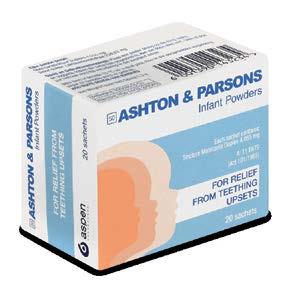
You love watching your baby hit those sweet milestones, the first smile and the first giggle. One milestone that is sometimes not so sweet is teething. That is because teething is one of those milestones that can bring discomfort, tears (for you and baby), and even sleepless nights. Most babies start teething around the age of 6 months, but some may start sooner or later.2
The most common symptoms of teething are mild irritability and lack of appetite. Other symptoms include drooling, chewing on solid objects, mild fussiness, crankiness and sore, tender, red and swollen gums1
You can relieve your baby’s teething pain by gently massaging your baby’s gums with a clean finger or holding a chilled (never frozen) teething ring for your baby to chew on to ease discomfort.1
For children teething and for slight stomach ailments occurring in infancy. Try ASHTON & PARSONS Infant Powders.
A baby is more likely to experience stomach discomfort when they are unable to pass gas. The good news is that there are ways to soothe your baby.3
Swaddling babies in a warm blanket and rocking them back and forth may calm fussiness. Soothing background noises, calming music or white noise can also help.3
Wearing babies under 6 months in a chest-to-chest carrier can often calm them, as can going for a walk outside in a baby carrier or stroller. The change of scenery can be calming for parents and infants. A brief car ride may soothe your baby, too.3
Try WOODWARD’S Celebrated Gripe Water, a tried and trusted medicine that comforts infants with gripes. WOODWARD’S Celebrated Gripe Water acts as a carminative and brings an acid neutralising action. It is available in 150 ml at selected retailers and pharmacies.

References: 1. Johnson S. [Internet]. Teething Syndrome: When Your Baby Starts Teething. 2017 Aug 17. Healthline.com. [Updated 2017 Aug 17; Cited 2023 Sept 26]. Available from: https://www. healthline.com/health/teething#outlook 2. Higuera V, Chertoff J. [Internet]. When Do Babies Usually Start Teething? Healthline.com. [Updated 2021 Nov 29; Cited 2023 Sept 26]. Available from: https:// www.healthline.com/health/parenting/when-do-babies-start-teething#symptoms 3. Higuera V, Holland K. [Internet].How to Use Gripe Water to Soothe Your Baby. Healthline.com. [2023 May 19; Cited 2023 Sept 26]. Available from: https://www.healthline.com/health/parenting/gripe-water-for-babies
S0 WOODWARD’S Celebrated Gripe Water. Reg. No.: E/11.4.3/1551. Each 5 ml contains 50 mg sodium bicarbonate and 2,15 mg terpeneless dill seed oil. S0 ASHTON & PARSONS Infant Powders. Ref. No.: E679 (Act 101/1965). Each sachet contains 4,055 mg tincture matricaria duplex Trademarks are owned by or licensed to the Aspen group of companies. © 2023 Aspen Group of companies or its licensor. All rights reserved. Marketed by Pharmacare Limited t/a Aspen Pharmacare. Co. Reg. No.: 1898/000252/06. Healthcare Park, Woodlands Drive, Woodmead, 2191. ZAR-ZOSEAG-10-23-00002 11/2023

To comfort infants with gripes.
Marketed by Aspen Pharmacare www.aspenpharma.com
Hotline 0800 122 912



The heat is here in more ways than one!
For me winter is a great time to spend some quality time with loved ones. It's the perfect excuse to bring out the board games or just curl up with a blanket watching movies.
The Philips Avent single electric breast pump is comfortable and convenient for new mothers keeping milk flow at an optimum and gently adapts to breast size and nipple shape. This palm size solution is portable, comes with a USB charging port to connect to a power bank and can be used with a breastfeeding bra for hands free usage.
Store and feed your breast milk efficiently, with the Philips Avent storage cups, compatible with the electric breast pump. It can be stored in the fridge and freezer and used safely in a bottle warmer, microwave, dishwasher, and sterilizer.


For many, winter also implies flu. I think ever since the COVID-19 pandemic hit, when we have a respiratory ailment we are confused about whether it's COVID, flu, allergies or something else. Be sure to check out the article on page 32 that highlights some of the differences between flu and RSV. The article also give some tips for prevention.
In this edition we cover some key topics for those embarking on a new chapter of parenthood such as detailing what to expect from a gynae (page 18) or a doula (page 22), and post-partum concerns (page 26). The article on page 24 also draws attention to the pressure put on mothers to conform to standards brought on by media regarding body image. For some, parenthood is a completely happy occassion, whereas for others it might feel a bit scary – the reality is that each person/couple has a unique journey. It has its ups/downs and lots of lessons along the way. It is really important to have a good support system and to be open with your medical professionals about concerns.
It is normal for parents to want to celebrate milestones, but these can also cause great anxiety when children develop at a different pace from each other. See the excellent article for parents on "How children learn to talk" (page 64).
Stay warm and stay healthy!




and needs to be admitted to hospital, our team at Life Kingsbury Hospital is here for you.
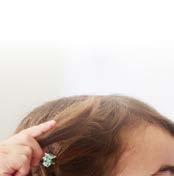














The Life Kidz paediatric unit at Life Kingsbury Hospital has been designed with you and your child in mind. Our clinical team of specialists and nurses will care for and nurture your child in a unit specially designed to make them forget that they are even in hospital – beds and blankets aside!
Paediatricians:
Dr Rabeen Lutchman
Dr Hazel Msimango
Dr Allan Puterman
Dr Lara Smith
Dr Hedi van der Watt
Paediatric Surgeon: Dr Shamaman Harilal
ENT Specialist: Dr Ola Basson
Dr Gary Kroukamp

For hospital information and specialist contact details.
Wilderness Road, Claremont, 7700 | Tel: 021 670 4000 24-hour emergency unit: 021 670 4039
www.lifehealthcare.co.za

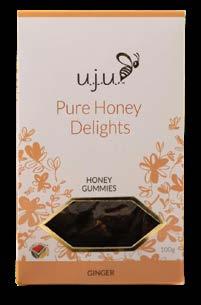


Panado – Top five facts about fevers

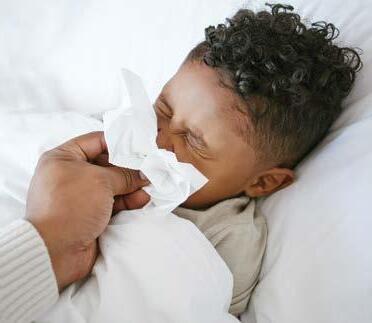
Terry and Amy went fishing in the river near his house. Terry’s takkies got wet and he wanted to let them dry off before the walk home. A few days later, he had a sore tummy and itchy feet.
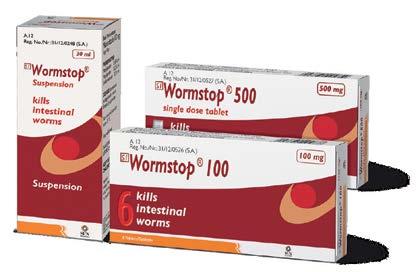




PUBLISHER: Elroy van Heerden Mays elroy@mediaxpose.co.za
EDITOR: Tashne Singh editor@babysandbeyond.co.za
SUB-EDITOR: Jacky Dyer sub@mediaxpose.co.za
CONTENT MANAGER: Wadoeda Adams artwork@mediaxpose.co.za
CONTENT ASSISTANT: Ketsia Makola ketsia@mediaxpose.co.za
EDITORIAL CONTRIBUTORS
DESIGN & LAYOUT
Shaun van Heerden Mays Anja Bramley
PROJECT MANAGER: Allison Davids allison@babysandbeyond.co.za
ADVERTISING SALES: Lorraine Beneke lorraine@babysandbeyond.co.za
DIGITAL AND SOCIAL MEDIA Kyla van Heerden Tia Arendse
DISTRIBUTION & SUBSCRIPTIONS: Shihaam Gyer distribution@mediaxpose.co.za
MEDIA PARTNERSHIPS: Maurisha Niewenhuys maurisha@mediaxpose.co.za
CHIEF FINANCIAL OFFICER: Shaun van Heerden Mays
WEBSITE ADMINISTRATOR: Justin McGregor
RECEPTIONIST: Daniëla Daniels
RETAIL DISTRIBUTION: On The Dot
AIRPORT DISTRIBUTION: Media Support
PICTURE CREDIT: 123rf.com /

Disclaimer: The views expressed in this publication are not necessarily those of the publisher or its agents. While every effort has been made to ensure the accuracy of the information published, the publisher does not accept responsibility for any error or omission contained herein. Consequently, no person connected with the publication of this journal will be liable for any loss or damage sustained by any reader as a result of action following statements or opinions expressed herein. The publisher will give consideration to all material submitted, but does not take responsibility for damage or its safe return.
CONTAINS ZINC OXIDE acts as a protective barrier, has anti-inflammatory and healing properties and protects the skin’s immune integrity
CONTAINS PANTHENOL
soothes and hydrates irritated skin and promotes skin barrier repair
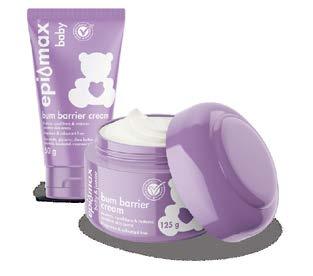
CONTAINS CORNSTARCH keeps baby comfortable A Proudly South African Brand.

Reference: 1. Data on file, Adcock Ingram. Epimax Baby Bum Barrier Cream, Product Information File Index. 2. Staughton J. 5 Incredible Zinc Oxide Benefits [online]. [cited 2024 Feb 20]; Available from: https://www.organicfacts.net/zinc-oxide.html. 3. Tee-Melegrito RA. What to know about panthenol [online]. [cited 2024 Feb 20]; Available from: https://www.medicalnewstoday.com/articles/ panthenol#uses. Adcock Ingram Healthcare (Pty) Ltd. Co. Reg. No. 2007/019928/07. Private Bag X69, Bryanston, 2021, South Africa. Customer Care: 0860 ADCOCK/232625. www.adcock.com. 20240222103434. February 2024.
TranquilTub™ is a luxurious bath soak designed to transform your bathing experience into a haven of tranquillity.
Crafted with a blend of carefully selected ingredients, TranquilTub™ combines the soothing properties of Magnesium Sulphate and the anti-inflammatory benefits of Cannabis Sativa Extract with a rich array of plant extracts and essential oils. This unique formula is designed to ease physical and mental stress, soothe tired muscles, hydrate the skin, and improve blood flow while enveloping you in a calming and restorative fragrance.
What sets TranquilTub™ apart is not just its effectiveness but also its commitment to sustainability. This vegan-friendly product is housed in fully recyclable recycled packaging and underscores Refresh Body and Mind's dedication to eco-conscious and ethical practices.
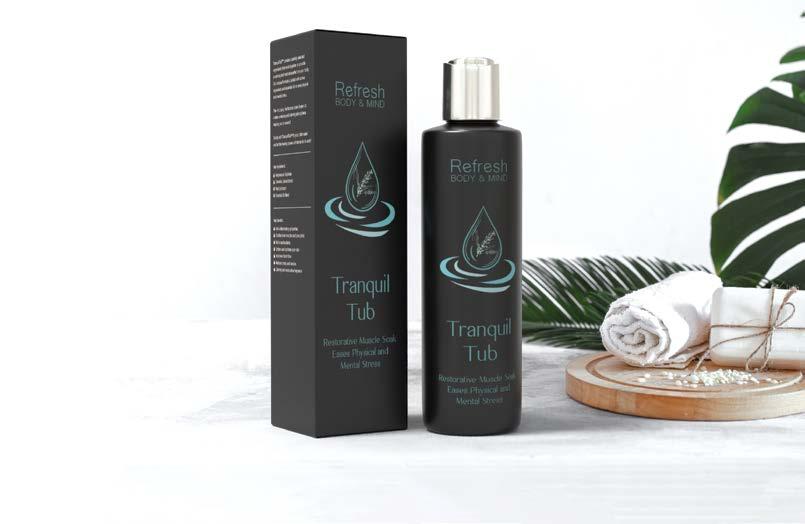



The vital baby® NOURISH Start Weaning Kit is the perfect combination of utensils and accessories for babies who are taking their first weaning steps toward independent eating and drinking.
Start weaning spoons have super soft, shallow tips and a built-in hygienic footrest helps to keep the tip off the tabletop. The scoop™ feeding bowl has scooped sides and channels to capture every drop of food and the lid with integrated spoon cover makes this set perfect for on-thego weaning. Store & wean™ pots are perfect for storing homemade foods and snacks, while the soft bases and sides make it easy to remove frozen foods from the pots. The Vital Baby mess catcher silicone bib is rollable for travel and fully wiped clean. Its integrated crumb catcher catches all runaway crumbs and spills. The free flow cup is ideal for first drinks and helps to teach sipping skills.
https://vitalbabyshop.co.za/

Dive into a winter adventure where every garment whispers tales of warmth and elegance.
Edgars’ newest collection blends comfort and charm, ensuring your little ones radiate both snugness and style this season. Encourage your mini fashionistas to unleash their individuality with our burst of lively colours and designs. Whether it's a day of carefree escapades or a cosy family retreat, Edgars Kids presents trend-setting ensembles to elevate your child's closet.

The nurtureOne™ nesting cushion was designed, and is endorsed by, medical practitioners, to meet the sensory needs of the premature baby and is used in intensive care units (ICUs) country-wide. Full-term babies (especially in their fourth trimester) also benefit from the nurtureOne™ nesting cushion. The cushion can be used by all new-borns until they outgrow it, which varies depending on the size of the baby, but in general is usually around seven months.
The specially designed nurtureOne™ nesting cushions provide the same sense of calm and security that babies felt in the womb, assisting in sustaining good sleeping patterns.



To enter scan the QR code with your phone and complete the entry form online at www.babysandbeyond.co.za/competitions/
000 Edgars voucher Closing date: 31 August 2024. T&Cs apply.

Dry air, cold weather, allergies, colds and ‘flu can leave your nose and lips chapped, red and inflamed. Frequently wiping a runny nose adds to the irritation. Letibalm helps to restore the skin barrier, soothes inflammation and forms a protective layer to help prevent further chapping.
Letibalm Nose & Lip Repair balm and fluid are suitable for adults and children three years and older. Letibalm Paediatric is safe to use from birth.


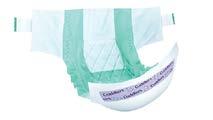





To enter scan the QR code with your phone and complete the entry form online at www.babysandbeyond.co.za/competitions/ Closing date: 31 August2024. T&Cs apply.
Getting a young child to take medicine can be a tough sell, especially if they’re feeling under the weather. It's essential to have a plan in place for when pain or fever strikes. The Panado® paediatric range is here to help!
Available in flavours that make the task a tad easier for parents and tastier for little ones, Panado®’s paediatric range of products for children includes: Panado® Paediatric Syrup Strawberry; Panado® Paediatric Syrup Peppermint Alcohol and Sugar-Free; Panado® Paediatric Syrup Peppermint 5 ml Sachets; Panado® Infant Drops; and recently launched, Panado® Paediatric Syrup –Grape Flavour which is colourant-free, tartrazine-free, alcohol-free, and sugar-free.
Parents trust Panado® for the power to fight their little one’s pain and provide relief when needed most. Panado® products are available at Baby City, Pick n Pay, Checkers-including Hypers and Shoprite, Clicks, Dis-Chem, and Independent Pharmacies. For more information, visit https://panado.co.za/.
Uju Pure Honey Gummies are delicious, chewy treats, which are sweetened naturally with local honey. They incorporate ingredients for various flavours and benefits such as:
Ginger: reduces inflammation in the body and aids digestion.
Chai: acts as an anti-oxidant in the body and can boost our immune systems.
Liquorice root: has been shown to help with stress-relief and regulating hormones.
Espresso: improves our mental alertness and concentration.
Rose geranium: studies suggest that rose geranium may possess antiinflammatory properties.
Rooibos: has anti-inflammatory and anti-oxidant properties.
Almonds: are high in antioxidant and vitamin E.


These treats are free from cane sugar, gelatine, colourants, flavourants, preservatives, gluten and dairy.
www.iloveuju.com
Each hamper contains a custom-designed clear Perspex organiser, mini first-aid kit and thermometer valued at R1 000! *Please note that the plush toy in the photograph is a prop only and is not included in the hamper.
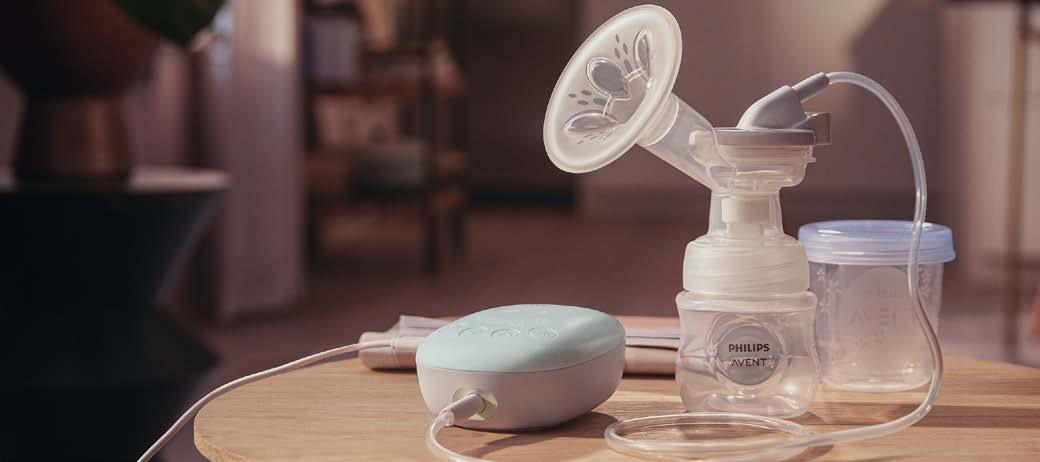



Described as two peas in a pod, and having been together for 13 years, Modise and Regomoditswe Khoele, socially known as Rego and Dise, are known for their adventurous life. They have embarked on their most thrilling adventure yet – parenthood!
What is the highlight of motherhood/fatherhood?
Rego: For me, it is being in awe of God’s creation through being pregnant, carrying a human being inside of me and birthing our son. I am captivated by our son’s beautiful features such as his eyes, hands, feet, smile, hair, gums, nose, ears, his tiny voice when he giggles and shouts – pretty much everything about him. Furthermore, I have been in awe of how my son and I have bonded from the womb until now during breastfeeding and downtime.
Dise: The highlight of fatherhood for me so far is finally having reached my childhood goal of being fruitful and multiplying as the Lord commanded us to do. In other words, starting my own family and the blessing of being in the position of greater leadership within our household has been the biggest high. I am in awe of the precious reality that our family’s legacy continues through our son.
What is most challenging about motherhood/ fatherhood?
Rego: Managing my time to fit in work, me time, wifey time, and being a mother.
Dise: At this early stage of fatherhood, the greatest challenge for me is having to accept that my wife’s attention is divided between myself and my son. I need to be more patient, understanding and supportive in raising our son.

What is most surprising about this new chapter?
Rego: The most surprising thing is the amount of love I have for my son and the love I receive from him. I didn’t expect it to be so overwhelming.
Dise: For me, it has to be how parenthood unlocks a deeper sense of love and appreciation for your spouse. Seeing my wife take on a role (motherhood) she has never experienced before, and doing all of it so brilliantly has been so humbling.

You are known for having a lifestyle of adventure and travel. How do you see parenthood impacting your lifestyle?
When it comes to adventure and travel, we see parenthood unlocking a new level of enjoyment of that lifestyle, and enhancing the experience as we intentionally create memories for our children to look back on. We now have a greater desire to be more adventurous and travel more often for our child's sake.
What advice would you give to expectant parents about managing changes that come along with having a new baby?
Our advice would be that both parents need to be patient with themselves and with one another. They need to give grace to one another and understand that it’s a learning journey and that they need to adopt their own methods of raising their baby.
Furthermore, we would advise that they communicate more intentionally about how they are feeling, what ideas or suggestions they have and, most importantly, they must understand that there will be some sacrifices that need to be made and accept that life will not be the same. They need to be willing to adapt to change and embrace the new dynamic in their relationship.
Before giving birth to Kgosietsile, you had bravely shared a bit about having a miscarriage previously on your YouTube Channel. Could you share how this experience impacted each of you?
Rego: Having lost our first pregnancy made me feel guilty as though it was my fault for the loss. I had never experienced loss to this extent before, and the reality of losing what could have been flesh and blood made me experience all the stages of grief and heal with time.
Dise: I felt defeated, powerless and robbed. Seeing my wife in so much emotional pain really broke me. All that I could do was remind her and myself, that God’s promise for us to have children would come to pass someday.

Many couples take a lot of strain when suffering a miscarriage. What helped you move forward as a couple?
Honestly, it was our faith in God and the community that we surrounded ourselves with. We constantly had people who love us reassure us of God’s wonderful plans to bless us with children and to not give up on trying to fall pregnant again.
When you fell pregnant with Kgosietsile, what were your initial thoughts?
Wow! Initially, we were in shock, then became excited but then the thought of our previous loss crept into our thoughts. Nevertheless, we quickly cancelled those

negative thoughts and leaned on the promises of God, knowing for sure that this pregnancy was going to be successful.
What's the significance of the name "Kgosietsile"?
The name “Kgosietsile” translated from seTswana to English, means “The king has arrived”. We had always hoped and prayed for a son as our first child and God made it happen. Looking deeper into the name, “Kgosi” which means “King”, speaks to the royalty that our son is to us his parents. We want him to understand that as a ‘King’ he is destined to be a great leader, to be confident and to be wealthy.
What is the greatest lesson you want to impart to your son as he grows?
We want to teach Kgosi to keep the word of God close to his heart. Furthermore, to strive to reach his goals and to be resilient despite setbacks.
Reflecting on your journey from high school acquaintances to lifelong partners, what are the key lessons you've learned about maintaining a strong relationship?
• Be intentional about the trajectory of the relationship (i.e. What is the end goal of the relationship?).
• Establish a genuine friendship as the foundation and bedrock of the relationship.
• Be willing to compromise on some of your own desires, for the joy of your partner.
• Be open to new experiences and adventure such as outdoor activities, travelling, date nights and meeting with other couples to learn and unlearn some habits.
• Invest in your relationship. Study each other’s love language and ensure that you meet those expectations.
• Last, but definitely not least, ensure that God is at the centre of your relationship. Pray for each other and serve God together.
How has your relationship as a couple evolved since becoming parents?
It has honestly definitely changed, for the better that is. We have had to embrace this new dynamic of being parents. We have had to reintroduce ourselves to each other since we have never known each other as parents. We are constantly learning to be patient, kind and show grace upon grace for one another.
Overall, we are falling deeper in love with one another as we witness each other in our new roles as parents. It’s quite charming and attractive seeing each other parent our son.

Fave travel destination: Paris, France
Number of countries visited: 9
Fave activity: playing soccer.
Guilty pleasure: ice-cream
Must-have item: camera
Motto to live by: draw close to God, and then you’ll find your purpose in life.
Best experience: deciding to do life with my then girlfriend and now wife and mother to our precious son.
Craziest thing I have ever done: skydiving in Dubai.
Stranded on an island, I would… spend quality time talking to God and reciting all the scriptures I can remember.
What would you say has been the most memorable moment on your relationship journey?
The most memorable moment was the birth of our son.
You are both entrepreneurs, content creators, and Rego is also a commercial pilot. With such a busy lifestyle, how do you prioritise creating lasting memories while managing the responsibilities of work and family life?
We have such a burning desire to create lasting memories that we have mastered the art of integrating content creation into our lifestyle. This has helped us to create genuine content that resonates with our audience because we stay true to ourselves and do not portray a false image of ourselves. We work around Rego’s schedule and take advantage of the time when she is home and available.
Ultimately, our work-life balance is intact.
What can we expect next from the Khoeles?

You can expect more family travel content and perhaps a sibling for Kgosi.
Fave travel destination: Paris, France
Number of countries visited: 16
Fave activity: dancing
Guilty pleasure: chocolate
Must-have item: lipstick
Motto to live by: God comes first.
Best experience: being pregnant and becoming a mother.
Craziest thing I have ever done: skydiving in Dubai. Stranded on an island, I would… do my best to survive.

The role of the gynaecologist in your planned pregnancy starts before you conceive and accompanies you throughout the journey until you give birth, providing a complete range of care services to ensure the best possible outcome.

counselling
The road to a safe, happy and healthy pregnancy begins long before you have a positive result on a pregnancy test. Preconception counselling is a visit with your gynaecologist where you discuss many aspects of pregnancy and plan for a healthy pregnancy.
Preconception care should be an integral part of primary care for women of reproductive age, especially those who are planning a family in the near future.
We recommend that you schedule a preconception appointment at least three months before trying to fall pregnant.
The doctor will conduct a physical exam to check the heart, lungs, breasts, thyroid, blood pressure and abdomen. Your weight will be recorded and the doctor will perform a pelvic exam.
Your gynae will also discuss the following with you:
• Your family history: your and your partner's family history can provide great insight into any genetic disorders or conditions that may be passed on to your child. Understanding your medical past can help your doctor treat you and your child in the future.
• Your general medical history: a doctor must know the whole picture of your health before pregnancy. Of importance is obtaining your underlying medical illness, such as hypertension, cardiac disease, diabetes, allergies, mental health history and medications you may currently be using that might need to be changed or stopped before pregnancy. They will also discuss previous surgeries, hospitalisation, transfusions, and other social issues.
• Your OB/GYN history: your past obstetric and gynaecological history is significant as it can directly or indirectly impact planned pregnancy, ability to conceive, or even carrying to full term. Many pregnancy risks may be reduced with good antenatal history, risk assessment, early intervention or treatment of underlying problems. Some STIs, previous cervical surgery or infections in the tubes may affect the ability to conceive. We do risk assessment screening like blood tests, cervical cultures, and pelvic organ scans to make sure there are no abnormalities that may affect conception or pregnancy.
Based on the results of the tests, we may make several suggestions after your appointment. These could be a mix of lifestyle and healthcare changes, including losing weight, quitting smoking or drinking, taking particular vitamins, updating your immunisations and avoiding certain medications that could harm the baby.
Pregnancy is an exciting time for an expectant mother. While this is a happy time, you must ensure your baby is healthy during pregnancy. This is where antenatal care comes in. Antenatal care is the healthcare and support you receive while you’re pregnant. This ensures you and your unborn baby are healthy throughout your pregnancy.
Gynaes offer antenatal care to pregnant women not only for the journey of pregnancy but also for the birth of their baby. We will confirm your pregnancy during your first antenatal appointment and discuss your gynaecological history.
We recommend coming for your first appointment between 7 and 10 weeks of pregnancy. The doctor will perform a dating scan during this appointment to see if it’s one or more babies. We also discuss necessary blood tests, screening tests and scans for the rest of the pregnancy. We take your medical and gynaecological history, discuss birth choices and answer any questions that you may have. Following this, the doctor will see you approximately four-weekly until 34 weeks, followed by fortnightly visits until 38 weeks, and finally weekly until your baby is born. Follow-ups depend on your risk profile.
The gynae performs the following screenings:
• Pregnancy diagnosis: a physical examination, laboratory evaluation, and ultrasound are used to confirm the pregnancy.
• First-trimester screen: an ultrasound between 8 and 12 weeks of your pregnancy to check on your pregnancy health and your baby's development in the first trimester.
• Second-trimester screening: taking between 15 and 20 weeks of pregnancy, these may include blood tests to provide information about the risk of having a baby with certain genetic conditions or birth defects.
• Maternal risk profile assessment:
a blood test combined with an ultrasound will be performed to determine the chance of an unborn child having Down's syndrome, Edward syndrome or a neural tube defect.
The gynae will prioritise any physical symptoms that may be plaguing you during your pregnancy, such as morning sickness, fatigue, weight gain and anxiety. The doctor will also offer advice on healthy eating and lifestyle changes.

The birth of a baby is undeniably one of life’s most special occasions, and our Melomed doctors strive to make your birthing experience unforgettable. Our doctors are here to support you with your care every step of your exciting journey to parenthood – during pregnancy, your delivery, and after your baby’s birth.
We know that although the prospect of becoming a parent is exciting, it could also be a time of uncertainty and anxiety as you prepare for the birth of your baby and the new responsibilities that come with it.
We encourage expectant parents to fully participate in developing a birthing plan that suits their needs, from the type of birth to who should support the mother during delivery and what kind of accommodation they would prefer.
Gynaes will help you develop a birthing plan that outlines your ideal birth, which may need adjustment as the situation unfolds.
Talk with your partner and decide who you want in the birthing room. Some couples feel this is a private time and prefer not to have others present. A birth plan may include other considerations like pain relief during labour and delivery positions.
Whether you prefer a natural vaginal delivery or a caesarean section, the Dr will be able to advise you on what may be best for your baby as well as what to expect from each choice.
At Melomed, we strive to create a safe, tranquil, friendly and supportive environment in our stunning well-equipped maternity unit with our skilled nursing staff to guide and assist you.






In the joyful world of motherhood, Portia M Body Care and Portia M Baby creates a caring paradise for both Mothers and Babies. While Marula Skin oil takes centre stage in prevention and treatment of stretch marks and skin marks for mom, the mild Portia M Baby care range provides a pleasurable and c o m f
s available in scented and unscented options for even the most delicate baby skin.

The word "doula" is a Greek word meaning women’s servant. Women have been serving others in childbirth for many centuries and have proven that support from another woman positively impacts the labour process.
By Dr Aneeqah HendricksWhat is a doula?

A doula is professionally trained in childbirth and provides emotional, physical, and educational support to a mother who is expecting, is experiencing labour, or has recently given birth. The doula aims to help women have a safe, memorable, empowering birthing experience.
What does a doula do?
Most doula-client relationships begin a few months before the baby is due. During this period, they develop a relationship in which the mother feels free to ask questions, express her fears and concerns, and take an active role in creating a birth plan.
Doulas do not provide any medical care. However, they are knowledgeable in many medical aspects of labour and delivery, so they can help their clients better understand the procedures and possible complications in late pregnancy or delivery.
During delivery, doulas are in constant and close proximity to the mother. They can provide comfort with pain-relief techniques, including breathing techniques, relaxation techniques, massage, and labouring positions. Doulas also encourage participation from the partner and offer reassurance.
After the birth, many labour doulas will spend time helping mothers begin breastfeeding and encourage bonding between the new baby and other family members.
Benefits of having a doula?
Numerous studies have documented the benefits of having a doula present during labour. A Cochrane Review, Continuous Support for Women During Childbirth, showed many positive birth outcomes when a doula was present.
With the support of a doula, women were less likely to have pain-relief medications administered and less likely to have a Caesarean birth. Women also reported having a more positive childbirth experience.
Other studies have shown that having a doula as a member of the birth team decreases the overall Caesarean rate by 50%, the length of labour by 25%, the use of oxytocin by 40%, and requests for an epidural by 60%.
The key to choosing a doula is finding a person you feel comfortable with.
• What training have you had?
• What services do you provide?
• What are your fees?
• Are you available for my due date?
• What made you decide to become a doula?
• What is your philosophy regarding childbirth?
• Would you be available to meet with me before the birth to discuss my birth plan?
• What happens if, for some reason, you are not available at the time I give birth?
W.O.M.B.S stands for Women Offering Mothers Birth Support and is the Doula Association in Cape Town. Contact them to find a suitable doula.
Melomed labour ward staff encourage doula support in pregnancy and labour, and the doula and partner are allowed to be in the delivery room.



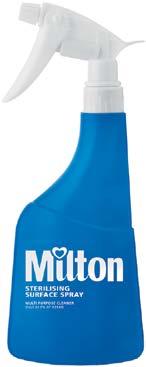

Motherhood is a transformative journey, a unique experience that uniquely shapes each woman. In today’s world, where social pressures abound, it’s essential to recognise the impact of unrealistic body standards on new mothers during pregnancy and postpartum.
By Vital BabyMany mums-to-be embrace their growing bellies, celebrating the life within, proudly displaying their baby bumps and appreciating the miracle of pregnancy. Other mums, however, may feel alienated from these changes and out of control of the adjustments inside and outside their bodies. Experiencing dissatisfaction with one’s body during pregnancy can have significant implications for both maternal and foetal well-being, leading some women to adopt extreme dietary restrictions or even trigger a relapse of an existing eating disorder.
One’s self-esteem can be further impacted when comparing oneself to unrealistic portrayals of pregnant women in the media, where stretch marks and uneven skin tone have been edited out. After birth, an obsession to ‘return to normal’ can be as damaging, leaving new mums feeling pessimistic and depressed about themselves instead of accepting that motherhood has upgraded them to a new life stage and status.
The reality is that the ‘perfect’ pregnancy body doesn’t exist. The true beauty of birth into motherhood lies in your authenticity. Understand that it’s normal to have mixed feelings about your changing body during pregnancy. Many women go through similar emotions. If you feel inadequate or negative about yourself, it can help to:
1. Shift your mindset from aesthetics to functionality. Marvel at how your body is preparing to grow and deliver a new life into the world.
2. Share your feelings with a trusted friend, partner, or family member. Talking openly can help lighten your mental load.
3. Take the time to honour yourself by appreciating the strength, endurance, and resilience your body exhibits during pregnancy and childbirth.
4. See it as an invitation to educate yourself and learn about the changes your body will undergo during pregnancy and postpartum so you can balance and support your mind and body better.
5. Create a pregnancy mantra or positive phrase. Repeat it regularly, especially when feeling low, and practise better self-talk.
Dispelling fears & myths
Pregnancy brings significant changes in all areas of one’s life, and the fear of the unknown may cause anxiety. As your body goes through the gestation phase, you will experience hormonal shifts, weight gain, bloating, mood swings, swollen feet, back pain, morning sickness and skin changes that can make some women feel helpless and overwhelmed.
While you may witness your favourite celebrity or influencer appearing to breeze through their pregnancy with perfect glamour, you are not seeing the full story of real life; everyone has low days where their biorhythms are on the fritz. Understand that it is the media’s job to Photoshop and gloss up for the best aesthetic look rather than reveal everyday practical roadblocks.
Challenge the myths circulating in women’s conversations and challenge yourself to decide what is true for you. For example:
MYTH: Pregnancy makes you hungrier. True. Pregnancy hormones often lead to an increased appetite; this is a natural body indicator for more fuel as you use more energy to grow a new person. Having more significant portions is normal.
MYTH: You need to eat for two. False. There’s no need to eat for two. Only in your third trimester do you need about 200 extra calories per day. Focus on a balanced diet and quality nutrition, which will satisfy you more.
MYTH: You should gain a kilogram a month throughout pregnancy. Not exactly.
Weight gain in pregnancy doesn’t happen evenly; most pregnancy weight happens after 20 weeks, and the recommended weight gain during pregnancy varies based on your pre-pregnancy weight and body mass index (BMI). On average, expect to gain 1 to 1.5 kilograms in the first three months (more if expecting twins) and 1.5 to 2 kilograms each month until delivery.
MYTH: Excessive weight gain is fine. False. Too much weight gain puts you at risk for gestational diabetes and preeclampsia. Aim for 11 to 16 kilograms (more for twins) if you are of average weight and height.
How to embrace your changing body
Focus on nourishing your body with wholesome foods and staying active – your well-being matters. Weight gain, stretch marks, and loose skin are natural parts of pregnancy, and age is a natural part of life.
Your growing belly is a testament to the life blossoming within. Each stretch mark tells a story of strength. See this period as a call to walk your path rather than following another. Appreciate motherhood as an opportunity to create a closer relationship with yourself as you take on the responsibility of nurturing another tiny human being.
Prioritise your well-being rather than focusing on attaining a specific appearance. Understand that your body is doing incredible work, and imperfections are okay. Consult a healthcare provider who can guide you through the physical changes and address weight concerns.
Learn about the changes you’ll experience with the support of the Vital Baby social media accounts, and connect to Sr Londe online, Vital Baby’s trusted advisor who provides advice through monthly Instagram Live videos for new mums and mums-tobe, answering your specific questions during the sessions. Connect to other moms and join support groups and online communities where you can share experiences and hear stories from other women, which can normalise the challenges and help you feel less alone.
Caput medusa or moulding occurs as the skull squeezes through the birth canal.

The experience of childbirth and parenthood is an unknown adventure, which brings about major changes in one’s life and family. All parents worry about the possibility of unexpected outcomes i.e. birth complications, prematurity, unforeseen abnormalities, surprise multiple pregnancies. Many parents are surprised or even alarmed at the first sight of their newborn. It’s important to understand the effects of birth and that these are usually temporary.
By Dr V Singata, Paediatrician
An abnormally shaped head
• Caput medusa or moulding occurs as the skull squeezes through the birth canal. The pressure can result in localised swelling or overlapping of the soft skull bones which resolves within a few days.
• A cephalhaematoma is a collection of blood beneath the scalp usually on one side, which may take a few weeks to resolve.
• Fontanelle, commonly referred to as soft spots on the head located posteriorly and anteriorly. They are triangular and diamond-shaped respectively. The spot at the back closes at around three months and the frontal spot within 18 months.

Abnormal-looking skin or skin colour
• Vernix is the waxy white substance that protects and lubricates the baby’s skin in the womb and comes off easily with wiping.
• Puffy eyelids and red marks on eyelids are usually due to instruments used to assist during the birth and they disappear within a few days.
• Milia is a fine white rash over the nose and face due to keratin that is entrapped just below the top layer of the skin and resolves spontaneously.
• Birthmarks are present at birth or are visible within the first month after birth. They are caused by an overgrowth of melanocytes (pigment cells) e.g. café au lait spots and “Mongolian spots”, or an overgrowth of blood vessels e.g. haemangiomas. “Mongolian spots” disappear by the sixth birthday.
• Jaundice is the yellowish discolouration of the skin and sclera due to a build-up of excess bilirubin. This usually presents a few days after birth. Most babies develop physiological jaundice which requires no special treatment. Those with pathological jaundice need more investigations to determine the cause and will require phototherapy.

Lastly, prematurity remains a major problem for all parents and healthcare providers alike as it is often not preventable. A baby born before 37 completed weeks is considered premature. A premature baby is ill-prepared for life outside the womb because all the organs are still growing and not yet functional. Thus, they need specialised care and attention. There are various causes of prematurity. Maternal and infant causes may be identified, however, at times no cause is found.
Premature babies will often have difficulty breathing due to premature lungs and thus need some assistance with ventilation. An underdeveloped immune system leads to a constant risk of infection. Strict infection control measures must be put in place such as stringent hand washing.
Temperature regulation is also problematic due to the lack of subcutaneous fat and a relatively large surface area, especially the head.
Feeding is also challenging as, in most, the sucking reflex is not developed and digestion is not yet established in a premature gut. They therefore need assisted feeding via tube or intravenously (parenteral feeds).
Chances of survival have improved vastly in recent years. The morbidity and long-term quality of life of premies is also much better than it was 20 years ago.
This is concerning as these babies have not grown adequately in-utero which can be due to internal factors in the womb e.g. infections, genetic defects or external factors such as maternal smoking, use of alcohol or poor maternal nutrition. Feeding after delivery is paramount for these babies.
The first 6-8 weeks after your baby’s birth is known as the post-partum period. It’s a time for readjustment for the baby, parents and the entire family. Taking care of your newborn baby does not require any special skills – just some basic knowledge, a lot of common sense and a willingness to seek help from healthcare providers.
“What good parents instinctively do for the babies is usually best after all.” –Benjamin Spock
Remember nobody has all the answers. Not even Dr Google.
Water birthing facility
3 labour wards & obstetric theatre
Vaginal births after caesarean section (VBAC)
Neonatal ICU
Private room with double bed to accommodate birthing partner

Gynaecologist & Obstetricians:
Dr Ilana Johnson
Dr Linda Murray
Dr Kate Richardson
Dr Amaal Schroeder
Dr Jacky Searle
Dr Latiefa Vinoos







Our team of Paeditricians and specialised nursing sta will do their utmost to ensure the comfort of your child in a safe, peaceful environment.
our specialised paediatric specialists
General Paediatricians
Dr Leon Jedeikin
Dr Carl Wicht
specialised paediatricians
Paediatrician and Nephrologist
Dr Paul Sinclair
Paediatrician and Allergologists
Prof Claudia Gray
Dr Candice Royal
Paediatrician and Neonatologist
Dr Lize Boshoff Coyles
Paediatrician and Pulmonologist
Dr Aruna Lakhan
specialists who provide paediatric services
Paediatric Dermatologist
Prof Carol Hlele
Paediatric Surgeons
Prof Rob Brown
Dr Babalwa Nondela
Dr Shamaman Harilal
Paediatric Orthopaedic Surgeon
Dr Stewert Dix-peek
Ear, Nose and Throat Surgeons (ENTS)
Dr Azgher Karjieker
Dr Eve Samson
Dr Martin Vanlierde
Dr Michele Long
Dr Paul Crosland

Paediatric Dietician
Susan Cooley-Maree
Orthopaedic, oncology, joint and Reconstructive surgeon
Dr Thomas Hilton
Dr Keith Hosking
Plastic & reconstructive surgeons
Dr Clare Neser
Dr Conrad Pienaar
Dr Gareth September
Dr Dehan Strüwig
Urologists:
Dr Larry Jee
Dr Karlheinz Jehle
Dr Allison Moore
In a medical emergency, call 0860 123 367 for our FREE advanced life support paramedic response car service. For more information about our service o erings please contact our units: Maternity: 021 506 5165 or Paediatric Ward and ICU: 021 506 5136/5137
Life Vincent Pallotti Hospital Alexandra Road, Pinelands, Cape Town, 7405
www.lifehealthcare.co.za

Whether you've recently given birth or are eagerly awaiting your little one's arrival, it's important to understand that nearly half of the population will experience haemorrhoids (commonly known as piles) at some point in their life.
Surprisingly, research shows that a significant number of individuals (52%) do not seek treatment for piles, with 44% delaying treatment. There is still a stigma around piles; people are often embarrassed to talk about them and would rather suffer in silence.
Pregnant women are especially prone to developing piles, underscoring the importance of debunking myths surrounding their nature and treatment. Piles occur when the veins around the anal region swell, causing discomfort such as pain, burning, and itching.
To address this issue, expectant and new mothers need to take proactive measures when it comes to piles. Increasing fibre intake, staying hydrated, and incorporating gentle exercises into daily routines can help promote regular bowel movements and reduce strain during childbirth and postpartum recovery.
Mothers should not hesitate to contact their healthcare providers for personalised advice and treatment options tailored to their needs. Persistent or severe symptoms may require medical intervention, and consulting with a healthcare professional can ensure appropriate care and management.
In addition to seeking medical advice, mothers can incorporate self-care strategies to alleviate discomfort associated with piles. This can include over-the-counter offerings to reduce pain and discomfort, such as AnuSol.
Experiencing piles during pregnancy or postpartum is a common occurrence and nothing to feel ashamed or embarrassed about. By normalising the conversation about piles, we can reduce stigma and encourage open dialogue

among mothers, ultimately promoting greater awareness, understanding, and support.
There are over-the-counter solutions like AnuSol, which contains a soothing astringent and provides relief, reduces swelling, soothes itching and eases the passage of stools. It is available in various formats, including suppositories, ointments, and wipes.
http://www.acdoco.co.za/buyanusol

Haemorrhoids are swollen veins in the lower part of the rectum and anus. They can cause discomfort, itching and sometimes bleeding, especially during bowel movements. There are both internal and external hermorrhoids, with varying degrees of severity degrees of severity and symptoms.



MBChB (Stell), FC Paed (SA), Cert Neonatology (SA), DCH (SA), Dip HIVMan (SA), MPhil Neonatology (UCT)
Respiratory Syncytial Virus (RSV) and influenza are two common respiratory viruses that can cause serious illness, especially in young children, older adults, and individuals with weakened immune systems. While both viruses can lead to similar symptoms, they are caused by different viruses and have distinct characteristics.
RSV was first isolated in 1956. It is a common virus that affects the respiratory tract and is highly contagious, spreading through respiratory droplets when an infected person coughs or sneezes.
RSV can cause a range of symptoms, from mild cold-like symptoms to more severe respiratory illnesses such as bronchiolitis and pneumonia. RSV is a significant cause of respiratory illness globally, particularly in young children and older adults. Young children are more likely to introduce RSV into the home, and to be infected. Locally, RSV poses a substantial burden on public health, contributing to hospitalisations and mortality, especially among infants and young children. RSV is the most common cause of bronchiolitis (inflammation of the small airways in the lungs) and pneumonia in children under one year of age.
Symptoms of RSV infection in infants may include coughing, wheezing, difficulty breathing, and a bluish colour of the skin due to a lack of oxygen.
RSV infection occurs in distinct seasonal patterns worldwide. In South Africa, RSV infection shows a predilection for the autumn and winter months. The RSV season started in week 6 (week starting 5 February 2024).
There is no specific treatment for RSV infection, and most cases can be managed with supportive care, such as rest, fluids, and feverreducing medications. In severe cases, hospitalisation may be necessary, particularly for infants and young children with breathing difficulties.

Prevention measures include isolation of children with influenza-like symptoms (sick children should not go to crèches or schools for a few days), and teaching children (and adults looking after infants) to practise sneeze and cough hygiene. The use of prophylactic antibiotics for children with upper respiratory tract infections is not recommended.
The monoclonal antibody, palivizumab, administered monthly throughout the RSV season to preterm infants and children at high risk of severe RSV disease, has been shown to be effective for prevention. However, the high cost and the need for monthly intramuscular injections throughout the RSV season limit its use.
Influenza, commonly known as the flu, is also a viral infection that affects the respiratory system. It is caused by influenza viruses, primarily types A and B, which can change rapidly, leading to seasonal outbreaks of the flu. Like RSV, influenza is highly contagious and spreads through respiratory droplets.
The symptoms of influenza are similar to those of RSV and can include fever, cough, sore throat, runny or
stuffy nose, muscle aches, fatigue, and headaches. Influenza can also cause serious complications, especially in young children, older adults, and people with certain underlying health conditions. These complications can include pneumonia, bronchitis, sinus infections, and ear infections.
In South Africa, the flu season typically occurs during the winter months, from May to September. The 2024 influenza season started in week 17 (week starting 22 April 2024).

Unlike RSV, there are antiviral medications that can be used to treat influenza. These medications work best if started within the first 48 hours of illness and can help reduce the severity of symptoms and the duration of the illness.
To combat the flu, the South African government typically promotes vaccination campaigns. Ideally, the influenza vaccine should be administered before the start of the influenza season because it takes about two weeks for antibodies to develop following vaccination. However, it is never too late to vaccinate. In South Africa, the flu vaccine is typically recommended for individuals who are at higher risk of complications from the flu, including:
• adults aged 65 and older;
• children aged 6 months to 59 months;
• pregnant women (the vaccine protects the mother as well as their babies from flu illness and flu-related hospitalisations for the first several months after their birth, when they are too young to get vaccinated); and
• individuals with certain chronic medical conditions (eg HIV/AIDS, diabetes, asthma and other lung diseases).
RSV and influenza are both respiratory viruses that can cause serious illness, particularly in vulnerable populations. While RSV primarily affects young children, influenza can affect individuals of all ages. RSV and influenza are a significant public health concern in South Africa, particularly among young children, and impose a substantial burden on healthcare systems. Vaccination against influenza and practising good hygiene, such as washing hands regularly and avoiding close contact with sick individuals, are important measures to reduce the spread of both RSV and influenza.
In the middle of winter, we all find ourselves either trying to avoid flu, or we are busy fighting flu. During colder temperatures in winter, the flu virus multiplies a lot faster and flourishes in your body once breathed in. Since the air is also drier when it is cold, germs hang in the air for much longer.
Make KuraFlo Hypertonic Saline solutions part of your cold and flu prevention this year.
Kuraflo Hypertonic saline draws fluid from the lining of the nose, sinuses, larynx and bronchi to help wash out those trapped bacteria and virus particles. The salt can also help dehydrate the bacteria and virus cells and kill them before they cause a respiratory infection.
If you are fighting the flu virus, Kuraflo Hypertonic saline will help bring down the swelling in the nasal cavities and thin the mucus and phlegm so that it can be coughed or blown out easier, giving you some much needed relief.
Also try our NEW anti-inflammatory, antibacterial & antiseptic KuraFlo
Skin Healing Cream now available from selected Clicks stores. Try it and see the difference.
• Skin infections • Skin Irritations • Scar treatment • Cuts & Abrasions • Insect bites • Nappy rash
KuraFlo – Helping you Breathe Better and now Feel Better too!
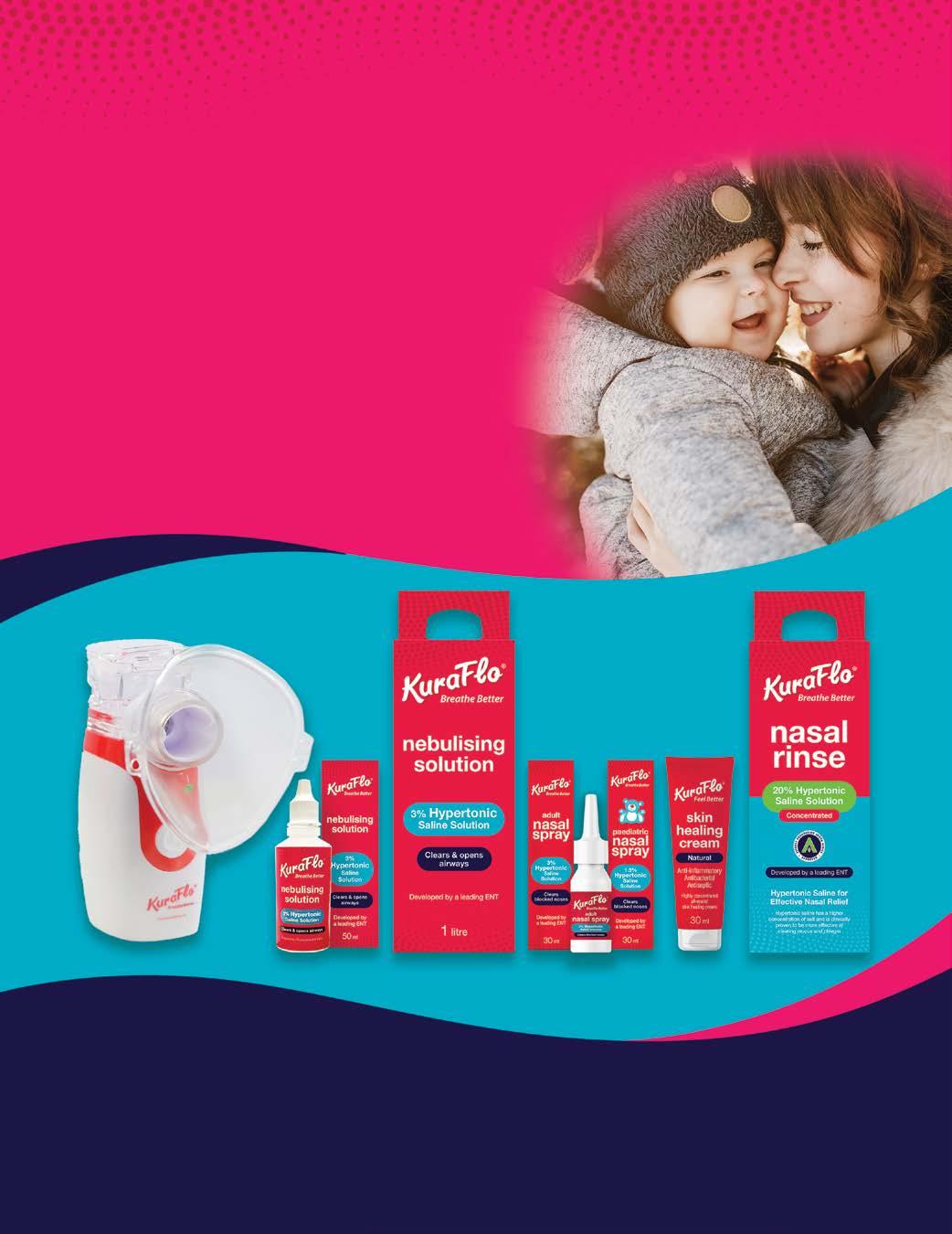


Fevers can be worrisome, yet the occurrence of one typically signifies activation of the body’s defence mechanisms.1 The good news is that symptoms can be relieved.

Fevers often get a bad rap. But before you declare war on this natural bodily response, let's dial down the thermostat and shed some light on the top five facts about fevers.
A fever is when your body's temperature rises higher than normal1 Fever indicates that your body is actively fighting off an infection. The existence of a fever often indicates the activation of the body's immune system. Fever can assist the immune system in its efforts to gain the upper hand against harmful agents like viruses and bacteria, consequently making the body less conducive to the replication of these temperature-sensitive pathogens.1 So, when you notice a fever, it's a sign that your body is doing exactly what it's supposed to do –protect you!
Not all fevers require an emergency response
When the temperature gauge rises, it's easy to hit the panic button. A fever in an adult is defined as a body temperature of 38° C or above2. Symptoms can often be managed at home with rest, hydration and over-thecounter medications2. However, if a fever is exceptionally high (over 40° C), or accompanied by confusion, seizure, difficulty breathing, or swelling of any body part, it's essential to seek medical advice.2
The reason behind chills
Ever wonder why we get the chills when we have a fever? It seems a bit odd, right? You'd think that with a higher body temperature, we'd feel warmer, not colder. But, those shivers are your body's clever way of fighting off the bugs that are making you ill. Germs don't like the heat, so when our immune system cranks up our body's temperature, we start to shiver3. This isn't because we're cold, but because our body is heating up to kick those germs to the curb!
Children and

When little ones have a fever, they might get cranky and could have trouble sleeping or eating. Older kids often don't feel like playing. Generally, the higher the fever, the grumpier and less interested in activities they might be. But, it's interesting to note that sometimes, even with a high fever, kids can still seem pretty perky and well. Fevers can be common in children and should be evaluated by a doctor if they have any worrying symptoms or are under the age of three months4.
The importance of nutrition and hydration
Let's bust an old wives' tale: "Feed a cold, starve a fever". Whether you have a cold or a fever, your body needs adequate nutrition and hydration to fight an illness. Replacing lost fluids and consuming enough calories is critical to helping your body battle infection.5
Panado® is trusted6 by South African families to offer relief of pain and fever associated with headaches, toothache, colds and flu. The range for adults is conveniently available in tablet, capsule or effervescent form to suit individual preferences.
For kids and babies, parents trust6 Panado® to be tough on pain and fever this, winter. The paediatric range includes peppermint flavoured syrup in convenient 5ml sachets, strawberry flavoured syrup, peppermint flavoured alcohol and sugar-free syrup, recently launched grape flavoured colourant-free, tartrazine-free, alcoholfree, and sugar-free syrup and peppermint flavoured infant drops with a dosage dropper.
Always administer using a medicine measure or a syringe. Do not exceed the recommended dose. Dosage details can be found at https://panado.co.za/dosage-calculator/ and are calculated according to your child's age and weight.

REFERENCES:
Embrace the Winter Warrior within with the Adcock Ingram Range, featuring brands Panado®, Cepacol®, Compral®, and ViralGuard™, available from Pick n Pay, Checkers including Hypers, Shoprite, Clicks, Dis-Chem, and independent pharmacies.
For more information about Adcock Ingram Winter Warriors, visit https://adcockwinterwarriors.co.za/. For more information about Panado®, visit https://panado.co.za/ and join the conversations on Facebook.

1. Scientific American. What causes a fever? Available from: https://www.scientificamerican.com/article/what-causes-a-fever/. Last accessed February 2024.
2. Harvard University. Fever in adults: when to worry. Available from: https://www.health.harvard.edu/diseases-and-conditions/treating-fever-in-adults. Last accessed February 2024.
3. Cone Health. Why Do We Get Chills With a Fever? Available from: https://www.conehealth.com/services/primary-care/family-medicine/why-do-we-get-chills-with-a-fever/. Last accessed February 2024.
4. MSD Manual. Fever in Infants and Children. Available from: https://www.msdmanuals.com/home/children-s-health-issues/symptoms-in-infants-and-children/fever-in-infants-andchildren. Last accessed February 2024.
5. Scientific American. Fact or Fiction?: Feed a Cold, Starve a Fever. Available from: https://www.scientificamerican.com/article/fact-or-fiction-feed-a-cold/. Last accessed February 2024.
6. Circana, MT, Jan 2024 MAT.
Globally, clubfoot is the most common musculoskeletal birth defect, affecting millions of children worldwide. Despite its prevalence, accessing treatment remains a significant challenge for families in resource-restricted countries like South Africa.
By KOJ Communication | Images: STEPSWhat is clubfoot?
A2023 study to determine new estimates of the global prevalence of clubfoot, published in The Lancet’s eClinical Medicine, revealed that 1.18 babies out of 1 000 births are born with clubfoot and highlighted significant incidence in the Southern Africa region. A local study published in 2022 in the South African Journal of Child Health estimated that 80% of the world’s clubfoot cases occur in low- and middle-income countries.
STEPS, a non-profit organisation working across South Africa and neighbouring countries to support families accessing treatment for clubfoot, approximates that prevalence in the region is at least double the global rate.
Founder and CEO of STEPS, Karen Moss, says, “We operate on the basis that two out of every 1 000 children will be born with clubfoot. However, a high rate of this congenital condition is just one of South Africa's many challenges. Clubfoot is a treatable birth defect. Early intervention can avoid costly surgical treatments, ensure that children can thrive, and prevent lifelong disability.”
Clubfoot develops in the womb, and babies born with the condition have one or both feet fixed in a downward and inward position. If the condition is left untreated, a child will not be able to walk properly and will experience chronic pain, muscle wasting in the legs and progressive degeneration of joints. On the other hand, most families that start prompt treatment using the Ponseti Method, the non-surgical global gold standard, have excellent outcomes.
Lifelong disability can be avoided
Moss says, “Aside from clubfoot, most patients are healthy babies. Studies have shown that clubfoot is successfully corrected in over 90% of cases using successive plaster casts and maintenance bracing as the baby develops. In most of these cases, children can walk, run, dance, and play as they grow up into able, contributing citizens. Therefore, becoming progressively disabled and living in pain due to clubfoot is completely preventable. While we can’t change the prevalence of clubfoot, there’s still so much that we can do to increase access to effective treatment for all South African families.”
In its advocacy for clubfoot treatment, STEPS identifies a lack of awareness and stigma and a lack of access to treatment
in local healthcare facilities. This, as well as economic factors, are significant barriers for families. Moss adds, “Clubfoot treatment requires frequent, time-bound visits to healthcare facilities to change the casts and monitor progress as the infant grows. It’s heartbreaking that so many South African families, particularly in the rural and resource-restricted areas don’t have the money to transport their babies to a clinic on a regular basis.”
In 2023, STEPS supported 4 703 children with 1 162 new patients enrolled across 40 partner clinics in South Africa. However, this is only around half of the estimated 2 295 new cases annually in South Africa.
The highest number of patients occupying the STEPS clinics are in Gauteng, followed by KZN and Eastern Cape.
Dr Yammesh Ramguthy, Paediatric Orthopaedic surgeon at Chris Hani Baragwanath Academic Hospital (Soweto), the biggest clubfoot clinic in Southern Africa, says, “The problem is the lack of skilled people to offer the treatment and the support needed after that. The cost of travel is also a significant factor. It would be much better if families didn’t have to travel across provinces for treatment. I pick up quite a few cases in our clinic that can be or should have been, managed better.”
What is clubfoot?
Clubfoot, or congenital talipes equinovarus, is a treatable birth defect. Children with clubfoot are born with one or both feet (unilateral or bilateral) twisted inward and pointed downward. The foot is rigid and cannot be pushed back into the correct position. Most children born with clubfoot are not missing any bones, muscles, or connective tissue. It is a congenital condition, meaning that it is always present at birth.
How common is clubfoot?
Clubfoot is the most common musculoskeletal birth deformity, affecting approximately 150 000-200 000 children annually. The majority of children born with clubfoot are in developing countries.
Does South Africa have a high incidence of clubfoot?
Does clubfoot occur in one sex more than another?
Clubfoot is more common in boys than girls. Researchers do not know the specific cause of clubfoot; it is an idiopathic (unknown cause) condition. However, if either of the parents were born with clubfoot, there is a higher chance that their children will have it.
Is the condition painful?
The condition is not painful for the newborn, but walking with an uncorrected clubfoot can be very painful and difficult, if not impossible.
What are the difficulties that children with clubfoot are likely to experience?

one in 500 children born in the region. This means that around 11 000 children are born with clubfoot in Southern Africa
Studies report that the Southern and East African populations have a higher incidence of clubfoot, affecting about 1 in 500 children born in the region. This means that around 11,000 children are born with clubfoot in Southern Africa every year, 2 000 of them in South Africa.
How do you know whether your child has clubfoot?
Parents will know if their child has clubfoot at birth because the condition is visible, and the foot is fixed in the position. Some cases are diagnosed during a routine ultrasound before birth.
Many older children live with the burden and stigma of untreated clubfoot. Untreated clubfoot has a long-term impact on a child’s quality of life. Children in outlying areas or depressed economic conditions are significantly affected by the lack of access to adequate care or information. These children face a life of disability due to untreated clubfoot, unable to wear shoes and unable to get an education, they are trapped in a cycle of poverty.
In the mid-20th century, Dr Ignacio Ponseti, an orthopaedic surgeon living in Iowa, USA, developed a less invasive method for treating clubfoot. The ‘Ponseti Method’ consists of using a series of casts, gentle manipulation and a clubfoot brace.
The treatment is in two phases:
Correction: the foot is gradually positioned into place with a series of manipulations and full-leg plaster casts, changed weekly over a 4-8 week period before a minor procedure is done in the clinic (tenotomy).
1


Maintenance: the child wears a clubfoot brace full-time for three months and then when sleeping. The clubfoot brace maintains correction until the foot stabilises at age four or five.
2
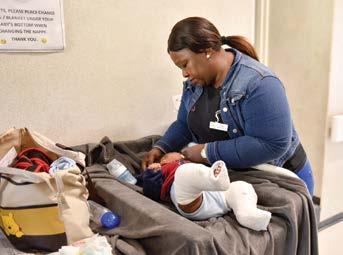
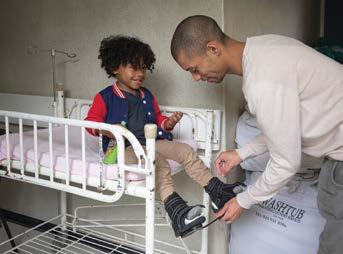
What is a clubfoot brace?
The clubfoot brace consists of shoes attached to an adjustable bar at a specific width and angle. The brace helps to keep the feet in the corrected position and is the most effective way of avoiding recurrence.
How effective is this treatment?
This treatment is over 95% effective and the most costeffective treatment with no side effects. The Ponseti Method is also very cost-efficient as it can be administered in low-resource settings, and various healthcare providers can perform the treatment, making the Ponseti Method a practical option for eliminating untreated clubfoot.
When should treatment start?
Treatment should start soon after birth.
Can clubfoot recur after a complete treatment plan?
Long-term research has shown that the Ponseti Method has the best results for clubfoot patients and is effective for older children, even in cases of failed surgery. Clubfoot recurrence is usually due to non-adherence, but treatment can be restarted, and correction can be restored.
STEPS CHARITY NPC was established in 2005 as the only NPO in South Africa focused on clubfoot support. STEPS founder Karen Mara Moss introduced the Ponseti Method to South Africa after her son was born with the condition in 2003 and was treated successfully by Dr Ponseti in Iowa, USA. STEPS organised Ponseti training in South Africa, Botswana, Namibia, and the Seychelles, which was welcomed and well supported by paediatric orthopaedic surgeons and other health professionals. This significantly revolutionised clubfoot treatment in South Africa.
STEPS launched a clinic support programme in 2013 to bridge the gaps in under-resourced state clinics. Focused on centred support, STEPS Clubfoot Care supports 38 partner clinics in the state health sector. www.steps.org.za



Beneficial
Improves
Boosts
Improves
Encourages


Affinity Health, a leading provider of high-quality health coverage, explores the myths and facts surrounding lupus.
Lupus is a longterm autoimmune condition in which the immune system attacks healthy organs and tissues, causing pain, swelling, and inflammation.
“Although no one knows what causes lupus, the Center for Disease Control and Prevention describes the possible cause as a mix of hereditary, environmental, and hormonal factors,” says Murray Hewlett, CEO of Affinity Health.
“Lupus can affect any part of the body, including the skin, joints, kidneys, heart, lungs, and brain, and its symptoms can vary widely from person to person. Lupus is a condition that affects millions of people worldwide and is still a mystery in many ways. Its global impact underscores the need for greater understanding and awareness.”
#1: Lupus is contagious
One of the most common myths about lupus is that it is contagious – it is not. Lupus cannot be spread through physical contact, saliva, or airborne particles.
#2: Lupus only affects women
While women are nine times more likely to develop lupus than men, it can affect both genders (and all age groups). The disease often presents differently in males, making diagnosis and treatment more challenging.
#3: Lupus is a mild condition
Lupus can have severe and potentially life-threatening consequences if left untreated or poorly managed. Symptoms include fatigue, joint pain, skin rashes, fever, hair loss, organ inflammation, and cognitive impairment. Lupus is also linked to an increased risk of cardiovascular disease, renal failure, and pregnancy difficulties.
#4: Lupus is easily diagnosed
Lupus is known as the “great imitator” because its symptoms often resemble those of other diseases, resulting in misdiagnosis or delayed diagnosis. To diagnose lupus, healthcare providers rely on a combination of clinical evaluation, medical history, laboratory tests, and imaging studies.
The “butterfly rash” on the face is one of the most recognised symptoms of lupus, but not everyone gets this rash. The absence of a rash does not rule out lupus.
#6:
Many people believe that sunlight does not impact lupus, but UV rays can trigger flare-ups in many individuals with the condition. Sunlight can worsen skin lesions and precipitate systemic reactions in susceptible individuals, making sun protection crucial for those diagnosed with lupus.
While lupus has no cure, some medicines may help control symptoms, prevent flare-ups, and slow progression. Nonsteroidal anti-inflammatory medicines (NSAIDs), antimalarial pharmaceuticals, corticosteroids, immunosuppressants, and biologic treatments are among the most regularly used medications for lupus. Treatment plans for lupus are individualised based on the severity of symptoms, the organs involved, and the patient’s overall health and lifestyle. In addition to medication, lifestyle modifications, such as stress management, regular exercise, and a healthy diet, can also play a crucial role in managing lupus and improving quality of life.
RESONANCE & NATURAL HEALTH

Reclaim your health and vitality by embracing ownership of your choices. Our holistic approach, grounded in advanced technology, whole foods and plant-based medicine offers a path back to balance and well-being. Remember, your body is a sacred vessel with an extraordinary capacity to heal itself.
Can’t Visit Us in Person? No problem! We can extract all the information through a the DNA sample of your hair, offering our services beyond the borders of South Africa.
At Vivid Health, we offer a range of advanced tools, including Quantum Technology, Magnetic Resonance Angiogram, Rife Electromagnetic Therapy, Ultrasound Therapy, and Distant Rife Therapy. However, we believe these tools are just aids. True healing lies in the choices you make, especially around food.
Our mission is to guide you back into the resonance of healing through a holistic, non-invasive, natural approach. Whether you are grappling with a common cold, flu, auto-immune disease, or chronic disease, our methods help restore balance using natural plant-based compounds , foods and frequency.
This journey begins with a comprehensive initial consultation lasting two hours. During this session, we conduct a quantum and NLS Bioplasm magnetic resonance scan to assess your body’s state. This in-depth analysis helps us tailor a personalized healing plan that aligns with your unique needs.

WE OFFER:
• Magnetic Resonance Scanning
• Ultrasound Therapy
• Nutritional medicine
• Rife Therapy
• Medicinal Mushrooms
• Quantum Analysis
• Bioplasm MRI Scanning
5 Station Street, Paarl, 7647
Contact: 072 566 8055
www.vividhealth.co.za
Obesity in children is a serious epidemic that has gripped South Africa and the world and has negative long-term health implications if not addressed early.
By Dr M Bassier
What is the definition of obesity?
Obesity is defined as excessive fat accumulation in the body. The standard measurement of body fat is determined by the body mass index (BMI). This measures the relationship between weight and height and is used in children aged two years and older. Weight status is categorised by BMI percentile curves (graphs) as:
Overweight if plotted between the 85th and 95th centile; and Obese if above the 95th centile for age and gender.
The most common causes of childhood obesity are related to environmental factors, with a small number linked to genetic diseases or hormonal disorders. Environmental influences include:
High caloric intake: sugarsweetened beverages (including fruit juice), high-fat, and high-salt foods. Families are increasingly being exposed to the aggressive marketing of the aforementioned foods and beverages, and together with reduced exposure to sound infant and child feeding practices, are engaging in unhealthy eating trends.
Sedentary lifestyle: television viewing and video games. Watching television displaces physical activity, lowers the metabolic rate and may encourage unhealthy eating practices through food advertisements and other food and beverage-related media.
Genetic factors and hormonal disorders account for <1% of all cases of obesity.
What are the complications associated with childhood obesity?
There are many adverse outcomes related to childhood obesity, but a few of the more important ones are as follows:
1. Cardiovascular disease:
• Atherosclerosis – this is the hardening and narrowing of arteries from plaque build-up. It ultimately increases the risk of adult coronary artery disease.
• Hypertension – the risk of high blood pressure is three times higher in children with a BMI above the 95th centile compared to those below the 95th centile.
• Hyperlipidemia – this is manifested by an elevation of LDL cholesterol and triglycerides and a decrease in HDL cholesterol.
2. Gastro-intestinal:
• Gallstones – gallbladder disease should be considered in any obese child who complains of persistent abdominal pain and non-specific symptoms such as nausea and vomiting.
• Non-alcoholic fatty liver disease (NAFLD) – most children are asymptomatic, but there may be non-specific complaints such as fatigue and abdominal discomfort.
3. Endocrine:
• Prediabetes and Type 2 Diabetes Mellitus are common comorbidities of childhood obesity. It is thus imperative to screen for these conditions in overweight and obese children.
4. Orthopaedic:
• Blount's disease – progressive bowing of the legs (angling of lower leg inward), which is secondary to the excessive weight load on the growth plate of the tibia.
• Slipped upper femoral epiphysis (SUFE) – obesity is a crucial risk factor for the development of SUFE and is characterised by the head of the femur slipping off the femoral neck.
3
Shortened sleep: mounting evidence points to an association between shortened sleep duration and obesity through possible alterations in the hormones involved in regulating appetite. There is also a longer period to ingest food if sleep duration is curtailed.
What measures can parents take to prevent childhood obesity?
• Exclusive breastfeeding for the first six months of life, followed by the introduction of complementary foods at six months.
• Reducing intake of energy-dense foods (foods with a high calorie content).
• Increasing consumption of fruits and vegetables.
• Decreasing sugar-sweetened beverages and increasing water intake.
• Maintaining appropriate portion sizes and avoiding adult plates when serving meals.
• Encouraging regular physical activity/ active play, which will increase energy expenditure.
• Limiting screen time (less than two hours of TV per day): no TV while eating or in bedrooms.
• Ensuring a good night’s sleep.
Childhood obesity is a serious condition and has detrimental effects on health if not addressed early. If you are concerned that your child may be overweight or obese, contact your healthcare provider for an assessment.

Unhealthy relationships with food can take many forms, affecting both men and women. They may not always be immediately recognisable as eating disorders, leaving many people to suffer in silence.
“The wide range of eating disorders and the ways they can manifest are so diverse, yet most people immediately think of anorexia nervosa or bulimia. Society often mistakenly associates eating disorders with women, overlooking the complexity of eating disorders,” says Marlene van den Berg, therapeutic programme manager and occupational therapist at Netcare Akeso Montrose Manor.
“One of the lesser-known eating disorders is orthorexia nervosa, which may be more prominent in cosmopolitan cities like Johannesburg or Cape Town where there is a particularly strong trend towards obsessive health-orientated behaviour.”
“A hallmark of orthorexia is that the person becomes overly fixated on health-conscious food and behaviours, and may not eat enough to sustain them physically,” adds Peta-Lyn Foot, therapeutic programme manager and occupational therapist at Netcare Akeso Randburg – Crescent Clinic.
“Orthorexia involves a compulsion for only eating ‘pure’ or subjectively ‘correct’ foods and feeling emotional distress connected to foods that do not fit in with these perceptions. Often beginning as a desire to eat more healthily or make more ‘clean’ conscious purchasing decisions, some people’s dietary choices may be taken to extremes and become overly restrictive.
“Some of the warning signs of orthorexia may include forgoing meals or missing social functions to avoid certain types of food or drink, or the person’s highly selective food preferences may make a nutritious balanced diet unaffordable or otherwise not supportable,” she says.
Van den Berg says that even though orthorexia is not necessarily associated with weight loss, people may also exercise excessively, trying to make up for eating
foods that don’t conform to their own self-imposed dietary ‘rules’.
“Often people with this disorder may project an image of being health conscious, but if taken to extremes the truth is to the contrary, as not only does this eating disorder signal deeper underlying emotional needs, orthorexia may also lead to nutritional deficiencies and avoidable sports injuries,” Van den Berg says.
“A healthy lifestyle must include balance and have healthy long-term implications. A good test is to check your emotional response if there is a day when you aren’t able to follow your preferred ‘healthy’ lifestyle, leading you to miss an exercise session or eat something outside your preferred diet. If you are being hard on yourself or feeling guilt or shame about it, it may be time to open up to a mental health professional.”
“Binge eating is another eating disorder that is too often overlooked or misunderstood, and it has a psychological basis for recurring episodes where the person loses self-control and feels compelled to eat a lot more food than would be usual in a matter of hours, often leaving the person with feelings of shame or guilt,” Foot adds.
Male eating disorders in particular are often misunderstood and easily missed...
Eating disorders and mental health
“It is unfortunately often hard for people suffering from binge eating to recognise that their behaviour is linked
to an underlying mental health disorder, and so it is even harder for them to seek help as the person may fear the stigma of being labelled as gluttonous or lacking discipline,” she says.
Mental health professionals such as those practising at Netcare Akeso Montrose Manor and Netcare Akeso Randburg Crescent Clinic recognise binge eating as a disorder, and multidisciplinary treatment coordinated by the Centre of Psychotherapy Excellence (COPE) programme is available for this as well as other eating disorders.
“Male eating disorders in particular are often misunderstood and easily missed, which means these conditions tend to be underreported. Many men grapple with stigma around male mental health generally, and when it comes to eating disorders, it may be even harder for men to recognise and address,” Van den Berg points out.
“In South Africa, there is a significant cohort of men with binge eating disorders, yet often adult male binge eating is framed as a food addiction and may present with other substance use disorders,” she says.
“There is no ‘quick fix’ for curing eating disorders, as these are complex psychological conditions that require emotional processing to address the underlying need the person’s relationship with food is attempting to fulfil, and this takes time and commitment.”
Foot urges anyone concerned about their or a loved one’s relationship with food to seek professional support. “If you or someone you know is showing signs that might potentially point to an eating disorder of any kind, do not ignore it. These disorders can progress quickly and impact all spheres of the person’s life if not identified and managed appropriately,” she says.
Contact Netcare Akeso for professional support. www.akeso.co.za


As a fitness instructor, I’ve witnessed first-hand the enthusiasm that comes with setting New Year’s resolutions, especially when it comes to health and fitness. Yet as the months pass by, many people’s New Year’s resolutions start fading and we fall into old habits, and our resolutions are a distant memory.
By Colleen Petersen, Owner of CrossFit AniWaya in Ruimsigccording to Enterprise Apps Today, only 9% of people successfully keep their New Year’s resolutions. Most people quit their New Year goals on the second Friday of the month.
Over the years, I’ve experienced hurdles and have seen my clients and friends go through the same self-inflicted limitations when it comes to fitness, which hinders us from achieving our resolution goals and leaving us feeling unaccomplished. From time constraints to lack of motivation, these obstacles can seem impossible to overcome, but they don’t have to be.
Here are my five tips to turn excuses into actions and reclaim your fitness journey.
1
It’s a common refrain: “I don’t have time to exercise, I wear many hats." But the truth is, we make time for the things we value. If exercise is an essential aspect of your life, you will find the time for it. Whenever someone says they don’t have enough time, I recommend challenging that notion. I recommend a “reality check”, simply starting a day plan, where you list all your day’s activities and the amount of time you spend on each activity – from when you wake up to when you go to bed. When you put pen to paper and break it down, where we spend our time is a big eye-opener. With this information, you can find space to carve out time for activities that nourish your soul, like fitness. It’s about prioritising and recognising that investing in your health is worth the time.
2
I’ve heard this line more times than I can recall. Many people find that fitness ends up being the last item on the to-do list, meaning that it frequently gets bumped off because we’re just too tired by the end of the day. So, finding the right time to prioritise exercise is crucial – whether it’s waking up 30 minutes earlier or squeezing in a short workout between meetings. It also doesn’t need to be at a gym; it could be a quick workout video online. Making fitness a non-negotiable part of your day can improve energy levels and overall well-being.
3
Sometimes, the hardest part is getting started. As human beings, our innate nature is to be social beings, which is why sometimes exercising by yourself can get monotonous. This is where finding a supportive community can make all the difference – joining a running club or finding a workout buddy who will keep you accountable. Another tactic to break inertia is the 5-second rule. Author Mel Robbins describes this rule: “The moment you have the instinct to act on a goal you must 5-4-3-2-1 and physically move or your brain will stop you. One thing guaranteed to increase your feelings of control over your life is a bias toward action.” So, if today is the day you have determined that you want to reclaim your fitness, the minute you think about it, you must physically do one small action, even if that means researching what you will do next.
Depending on your fitness journey, it is easy to fall prey to your mind where you are afraid you will look silly exercising, especially in a gym or training environment. The fear of judgement can be paralysing, but it’s essential to remember that everyone starts somewhere. There is also a physiological way to “get out of our heads”. When we are excited or scared, our bodies release cortisol.
It’s released similarly, but the difference is what our brains do with the information.

4
It’s important to realign our thinking and give our brains the correct information by being determined to turn fear into excitement. By reframing fear as excitement and creating positive pathways in our brains, we can overcome self-doubt and take the next step towards growth.
5
Many people view fitness as a luxury rather than a necessity. We need to start changing the narrative and categorise fitness as a top priority because investing in our health is one of our most valuable investments. It doesn’t have to break the bank either; there are so many costeffective training activities that you can participate in, and one of the great things about our information age is that we have knowledge right at our fingertips, so access to information, training programmes or motivation is readily available. One way to start is by finding someone with a fitness platform online, following them, and doing their home workouts. When you are ready, investigate what fitness options suit your needs and find an environment that matches that within your budget.
In essence, we must change how we view fitness; it’s about overcoming mental barriers and finding balance in our busy lives. Addressing common obstacles and implementing practical strategies can reignite our motivation and get us back on track towards a healthier, happier lifestyle. Fitness can be as simple as spending 20 minutes playing ball with your children or walking briskly in the park. Remember, every step brings us closer to our goals, no matter how small. So, let’s lace up our sneakers, embrace the journey, and reclaim our fitness one day at a time.
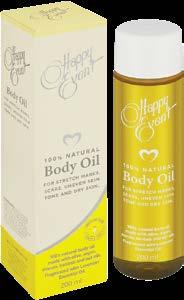
Happy Event
For over 50 years, Happy Event has been a trusted name in skincare, offering world-class quality products that cater to the needs of mothers. Committed to providing effective and safe solutions, all Happy Event products are vegan, cruelty-free, and formulated with natural ingredients to promote radiant, healthy skin. www.happyevent.co.za

2
Hask Sensitive Care
Fragrance Free Shampoo
Gently cleanses and removes impurities without causing irritation or discomfort. It’s formulated with a soothing blend of oat extract and provitamin B5 to help protect and moisturise for healthylooking hair and happy-feeling skin.
Available at Clicks, Dis-Chem and Takealot.
nurtureOne™ nesting cushion
This was designed and endorsed by occupational therapists to meet the sensory needs of the premature baby and is used in intensive care units (ICUs) countrywide. Full-term babies (especially in their fourth trimester) also benefit from the nurtureOne™ nesting cushion. The nurtureOne™ nesting cushion assists with a snug position for sleeping, which in turn encourages calm and relaxation. www.nurtureone.
co.za
4

Available in a wide range of different scents and variants, with something to suit every preference. Original offers a gorgeous fragrance comprising feminine notes of bergamot, rose and musk. Dreamer features the most beautiful delicate fragrance notes of cotton and musk. If tropical fragrances are the way to your heart, then you’ll love Paradise, which is filled with the scent of tiare flower and coconut. Available at Clicks stores and online at www.clicks.co.za

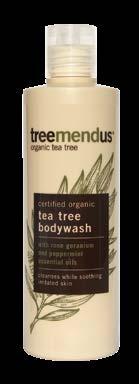
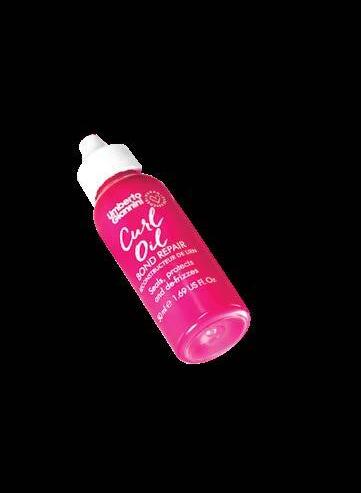

NURTURE
Flexcone Electric Breast Pump
7
The vital baby® NURTURE™ flexcone™ electric breast pump together with its incredibly soft silicone breast cup and flexcone™ provides gentle cushioning around your breast and mimics the suckling action of your baby to provide natural and effective breast milk expression. Available at Clicks, Dischem and BabyCity. www.vitalbabyshop.co.za
9

8
Tiggles® Baby Oil
Contains a blend of natural ingredients oils such as Sweet Almond Oil, Grapeseed Oil, Sunflower Oil, Rosemary Extract, calming Lavender Oil and Coconut Oil that helps to keep your baby’s skin soft and hydrated. Available at Clicks and online at https://tiggles.co.za

Tiggles® Body Lotion
This gentle formula helps to soothe and moisturise your baby’s delicate skin. Infused with softening coconut oil, jojoba esters and vegetable oils. Available at Clicks and online at https://tiggles. co.za
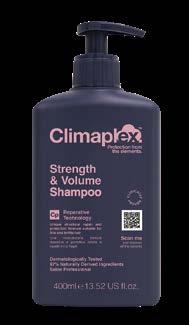
11
Safety 1st Outlet Plug
Protectors
Made with rounded edges that are child-resistant, these durable plastic gadgets fit snugly into an electrical socket, sealing it and protecting baby
Climaplex™ Strength & Volume Shampoo and Conditioner
Clinically proven shampoo and conditioner that protects the hair and scalp from the elements and pollutants, while effectively cleansing, conditioning, volumising, repairing, strengthening, hydrating, and smoothing the cuticles from the roots to the ends. It is suitable for all hair types and textures, and gives extreme shine, a gloss effect, softness, and eases detangling and control.
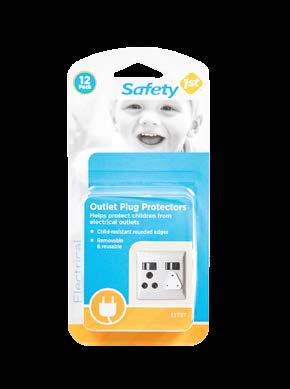
13
Philips One
10
Tiggles® 2-in-1 Baby Shampoo & Conditioner

A gentle and mild sulphate-free cleaning formula infused with softening conditioning ingredients such as Coconut Oil and Plant Glycerin that will leave your baby cleansed and smelling cuddly. Available at Clicks and online at https://tiggles.co.za
The sleek and stylish Philips One gently cleans and whitens your teeth. Each of the hundreds of soft bristles is transformed into micro-vibrating mini scrubbers by a tiny motor inside the handle. At the touch of a button your teeth are gently cleaned and whitened. The dynamic pattern of the soft bristles can help reach into the areas between teeth for thorough cleaning. One battery lasts up to three months. www.sonicare. co.za



* Survey conducted among the skincare market carried out by APLUSA and other partners between January 2023 and May 2023, involving dermatologists in 34 countries, representing more than 80% of the worldwide GDP.

1x APPLICATION PER DAY KEEPS THE RELAPSES AWAY

** Clinical study, 99 volunteers using Lipikar Baume AP+M or control emollient once a day for 4 weeks. Observational study, 261 volunteers, with Lipikar
AP+M once a day for 30 days.
The search for the perfect skincare regime often leads us to explore a plethora of ingredients promising radiant, healthy skin. This winter, as the chill sets in and our skin calls for extra care, the spotlight is on a handful of powerhouse elements that are trending and backed by science for their rejuvenating effects.
“The key to surviving winter skin –redness, dryness, flakiness, irritation, itching, overall sensitivity – is to incorporate ingredients to help nourish, hydrate and protect the skin,” explains the marketing manager for Vitaderm, Ruan Winter. Among the most sought-after are Vitamin E, Vitamin A, Ceramides, Hyaluronic Acid, and Vitamin C – each offering unique benefits to combat the harsh effects of the season.
The protective shield, embraced for its potent antioxidant properties, Vitamin E emerges as a winter skincare hero. Its ability to neutralise free radical damage helps shield our skin from pollution, sun damage and certain foods we consume. Plus, it assists in protecting our skin from environmental aggressors like harsh winds and indoor heating, which can strip away moisture and lead to dullness. It aids in strengthening the skin barrier, reducing water loss, and promoting a supple, nourished complexion – perfect for combating the dryness that often accompanies winter.
The age-defying elixir, Vitamin A, especially in the form of retinol, remains an unbeatable ally for more youthful, glowing skin. Renowned for its cell turnover prowess, retinol helps to diminish the appearance of fine lines, wrinkles, and uneven skin tone. In winter, when our skin’s renewal process can slow down due to the colder, drier air, incorporating Vitamin A into our routines can revitalise and rejuvenate.

The moisture lockers. In the battle against winter dryness, ceramides come out on top as the ultimate moisture saviours. These lipid molecules are naturally found in the skin, forming a protective layer to prevent moisture loss. When temperatures drop, and our skin’s barrier weakens, ceramides step in to replenish and restore, leaving the skin soft, smooth, and hydrated.

Hyaluronic Acid
The hydration magnet, Hyaluronic Acid (HA), has long been celebrated for its exceptional ability to attract and retain moisture. In the winter, when dry indoor heat can leave our skin parched, HA becomes a coveted ingredient. By drawing in moisture from the environment and deeper layers of the skin, it plumps up fine lines and restores a healthy, dewy complexion.
Vitamin C
The brightening booster.
A powerhouse for your complexion, Vitamin C not only helps to fend off environmental stressors but also works wonders in combating dullness and uneven skin tone. As the colder months can leave our complexion looking lacklustre, Vitamin C swoops in to restore radiance and luminosity.

APPLY SHAMPOO. TO DETANGLE LENGTHS. NO WEIGH DOWN!
AS A LEAVE-IN, ON DAMP OR DRY HAIR:
APPLY TO LENGTHS FOR 3-5 MIN. RINSE THOROUGHLY. NOURISH LONG, DULL HAIR!
APPLY TO LENGTHS FOR 3-5 MIN. RINSE THOROUGHLY. NOURISH LONG, DULL HAIR!

PLUMPING WATERMELON HAIR F0OD
FOR FINE HAIR

NOURISHING BANANA HAIR F0OD
FOR DRY HAIR







SMOOTHING



Karen Bester, Medical Trainer at Lamelle Research Laboratories, answers the most common questions about acne and breakouts.
There is no unequivocal evidence that proves that diet is linked to acne or the worsening of breakouts.
I'm no longer a teenager, but I'm suddenly experiencing breakouts again. Why is this happening to me as an adult?
We all assume that you should only get breakouts in your teens. Even though this is the one time your body is going through a massive hormonal change, this is not the only time it happens. Breakouts indicate a change in hormones; we have a few phases in our life when this happens.
What is the difference between breakouts and acne?
Changing environments can cause the odd pimple, stress, an area of clogged pores or maybe after a peel or resurfacing treatment that creates change in your skin. There would be no irregularity about a breakout. Acne is a chronic condition that is driven by hormones and probably has a link to your genetics. It will worsen with stress and hormonal change. It can also vary from very light to full inflammatory cystic acne.
Can my diet lead to breakouts?
That is an interesting question. There is no unequivocal evidence that proves that diet is linked to acne or the worsening of breakouts. If there were a strong link, there would be populations that don’t have acne and where these foods might be excluded from their diets. No population is excluded from acne and breakouts. However, there are individual anecdotal links to diet, which cannot be denied.
One of the drivers of male hormones in
Can wearing makeup cause breakouts?
Wearing makeup does not cause breakouts, but removing makeup and sleeping with thick layers of makeup on your skin might cause breakouts. Once again, this will vary from person to person. Makeup does not cause acne, though. Hormone fluctuations and genetic pre-disposition do.
PCOS is insulin resistance. So, in the PCOS patient, sugary diets and a diet high in carbohydrates might worsen their acne anecdotally.
What skincare ingredients and products should I use to clear blemishes and prevent new ones from forming?
For the odd pimple we love salicylic acid, azelaic acid and niacinamide. These could be included in a cleanser spot treatment or moisturiser. Add a retinoic acid ester to that if you have acne. It is generally used at night in a moisturising cream or additional serum used with moisturisers.
What should (and shouldn't) I do when I notice a new pimple? Keep calm. Don’t fiddle.
At Lamelle, we use our Clarity Active Control spot treatment, which contains ingredients that calm inflammation, kill bacteria in the pore, and remove any pore blockage.
Is it normal to develop acne after menopause?
Perimenopause and menopause are one of the times when females have enormous fluctuations in hormones as their ovaries stop their hormone production. This means that there is a lot more male hormone action in their bodies – the female hormones would previously control these. So, it is very typical for women to have oilier skin, get more breakouts and even start losing their hair – all driven by testosterone.
How can I maintain an antiageing routine while managing breakouts?
When using Retinoic acid, as in our
Clarity PM Plus and RA Correctives, you manage the breakouts and add a powerful age-prevention ingredient to your skin. Retinoic acid increases skin turnover and shedding in the top layers of your skin. This keeps that layer younger and healthier. Retinoic acid also removes elastosis; when you use it for more than ten months, it will show significant collagen production.
Additionally, niacinamide is antiinflammatory and anti-ageing. It helps our skin make good lipid bi-layers vital to age prevention and correction.
Nobiletin is another interesting ingredient. Dermaheal is used because it stops the genetic triggers that cause chronic inflammation, which is a key to our skin getting old. We use it in Clarity because it decreases the size of enlarged sebaceous glands in acne and makes sebum less sticky.
So, when you have acne and are using Clarity and Acnevelle Plus, you do not need to worry about ageing, as Lamelle is already helping you with that.
Are there any lifestyle habits that can lessen my breakouts?
A lot must be said for keeping skin clean and healthy. This is done by cleansing and moisturising the skin twice a day with the correct products for your skin. If you notice a lifestyle habit affecting your skin health, try to avoid it. Don’t pick at your skin or pimples, and avoid touching your skin too much, as our hands tend to be dirtier. If you often get breakouts around your hairline, wash your hair regularly. The scalp tends to be oilier at the hair follicles.
www.lamelle.co.za














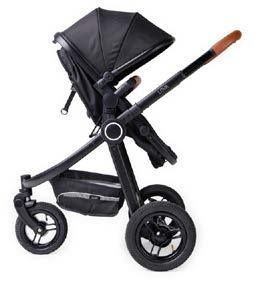


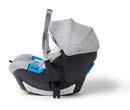































burn injuries are distressingly common and a major cause of death and disability in South Africa.

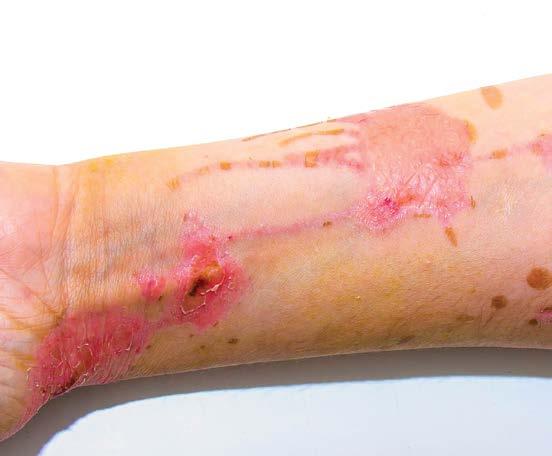
incidents and the critical role of immediate, proper first aid in the healing process.
“Common causes of burns, such as hot water, fire and electrical mishaps, highlight the necessity of proactive prevention measures,” she says.
“Children are naturally curious, and as soon as they become mobile or start walking, they begin exploring their environment. They may, for example, try to pull pots or kettles filled with boiling water down, touch hot objects like stovetops, or play with fire, matches, or candles. Unfortunately, indoor fires caused by candles or paraffin lamps left unattended and primus stove explosions are all commonplace in South Africa. We also see electrical burns fairly often.”
Emphasising the role of education, Toubkin advocates for simple interventions like containing flames with sand-filled bottles and educating children on fire safety techniques. She also shares guidelines for determining burn severity and the basic do’s and don'ts of first aid, ranging from remaining calm to avoiding home remedies, which serve as crucial guidelines for effective intervention.
Highlighting the determining factors of burn severity, Toubkin stresses the critical need for tailored treatment and timely access to specialised care.
• Superficial partial thickness (first-degree burns): typically heals with minimal scarring.
• Deep partial thickness (second-degree burns): seek medical advice for severe pain and blistering.
• Deep thickness (third-degree burns): require immediate medical attention due to extensive damage.

Do’s and don'ts of first aid for burns
Do’s
• Remain calm: keeping a level head is crucial in any emergency.
• Extinguish flames: teach the ‘Stop, Drop and Roll’ technique, especially to children.
• Ensure safety: prioritise safety, especially in electrical or chemical burn cases.
• Cool the burn: run cold water over the affected area for at least 20 minutes.
• Seek medical help: call emergency services immediately for appropriate assistance.
• Address smoke inhalation: prompt evaluation is crucial to prevent complications.
Don'ts
• Do not try home remedies: avoid applying ice or oily compounds to burns.
• Do not peel blisters: opening blisters can increase infection risk.
• Do not underestimate the severity: consult medical professionals for proper assessment and treatment. Understanding burn severity
Burns prevention tips
• Adjust geyser temperatures to prevent scalding.
• Control bathwater temperature to avoid burns.
• Keep hot appliances out of children's reach.
• Maintain fire extinguishers and smoke detectors.
• Exercise caution with flammable substances and heat sources.
• Do not use liquid accelerants to start fires.
• Ensure electrical safety and responsible smoking habits.
"Most burns patients, even those with burns over more than 70% of their bodies, can be successfully treated and managed if admitted timeously to a specialised, multidisciplinary burns facility such as the burns unit at Netcare Milpark Hospital.
“However, an effective continuum of care, from the paramedics who first attend to the emergency through to final rehabilitation, is critical to achieving such positive outcomes,” adds Toubkin.
“Having witnessed the plight of so many seriously injured and desperately ill patients, many of whom are young children, I urge everyone to educate themselves and their loved ones to help prevent burns. Together, we can effectively reduce and mitigate the toll of burn injuries, offering hope and healing to those in need,” concludes Toubkin.

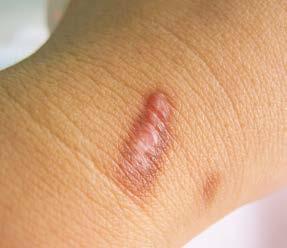
More about the Netcare Milpark Hospital Burns Unit
The Netcare Milpark Hospital burns unit, established in August 2008, is a premier centre of excellence equipped to handle the most challenging burn cases. With eight private isolation rooms, including ICU beds and a dedicated burns theatre, the unit emphasises the importance of isolating patients to prevent infections within a level I accredited trauma centre. Patients from across the country and throughout the African continent are referred to this state-of-the-art facility for specialised care, showcasing its profound impact on the lives of burn patients.



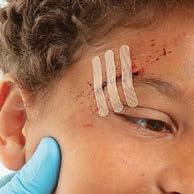
Adhesive wound closure strips for minor cuts and lacerations

For minor to medium sized, low to moderately exuding wounds such as cuts, grazes, and abrasions

For minor to medium sized , low to moderately exuding wounds such as cuts, grazes, abrasions and other minor wounds
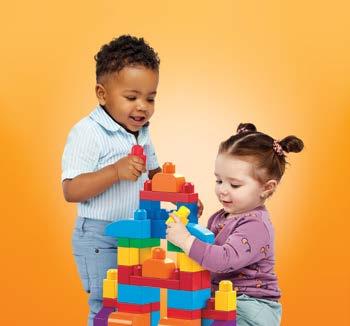
In our fast-paced world, where digital screens often dominate our children's attention, the importance of good old-fashioned play is necessary. Playtime serves as a crucial arena for the development of vital life skills. Here are three underestimated superpowers of collaborative play and the profound impact it can have on our little ones.
Picture this: a group of kids huddled together, their heads bent over a pile of colourful building blocks, with chatter filling the air. This scene is not just a heart-warming display of childhood camaraderie; it’s a classroom where the curriculum revolves around teamwork.
Collaborative play lays the foundation for improved communication skills, teaching children the art of expressing ideas, listening to others, and finding common ground. As they work together to bring
Stand a chance to win!
MEGA Bloks
their imaginative visions to life, kids learn the delicate dance of cooperation. Each child’s contribution is valued in this shared space, fostering a sense of inclusion and belonging.
Navigating the maze of shared problem-solving
Life is full of challenges, and learning to navigate them with others is a skill that can be honed during playtime. When children engage in group play, they encounter obstacles and puzzles that require joint effort. This shared problemsolving sharpens their critical thinking
Two Fisher-Price MEGA Bloks bags worth R449.99 each are up for grabs! These sets are a catalyst for shared adventures, teamwork, and the development of lifelong social skills. In the world of MEGA Bloks, children don't just build structures; they build bonds and create memories that will last a lifetime.

To enter scan the QR code with your phone and complete the entry form online at www.babysandbeyond.co.za/competitions/
date: 31 August 2024. T&Cs apply.
skills and teaches them that collaboration can lead to innovative solutions.
In the process of building, creating, and problem-solving together, kids discover the magic of synergy – where the combined efforts of a team yield more significant results than those of individuals. These lessons extend beyond playtime, creating a future where collaboration is a natural part of their toolkit.
As children collaborate, they naturally develop a heightened social awareness. They learn to navigate the intricate dynamics of group play – negotiating roles, understanding the importance of compromise, and celebrating shared achievements. This social education is a powerful force that extends into their interactions outside of playtime, laying the groundwork for positive relationships throughout their lives.


Speech is the verbal production of language; it’s the articulation of words. Language is one of the most highly developed human skills, allowing us to communicate. For communication to be effective, a child needs to understand (receptive language) and convey information (expressive language).By Dr Hazel Msimango, Paediatrician at Life Kingsbury Hospital
Speech is developed through hearing, understanding, word and thought processing, voice production and articulation. In 97% of right-handed individuals, the brain’s left hemisphere controls language and speech production. For effective language and speech development, coordination between the ear, brain, respiratory muscles, larynx, tongue, and oral cavity is needed.

The first three years of life are crucial for speech and language development. It’s at this time that the brain is maturing the most. These skills develop best when infants and toddlers are exposed to an environment rich in sound and sight and constant exposure to speech and language.
The first sign of communication is when the infant learns that a cry will bring food, comfort and companionship. Newborns can recognise important sounds in their environment, like their mother’s or primary caregiver’s voice. From six weeks, babies begin to coo and smile. In the next few months, up to 12 months, they start babbling and use non-crying sounds to get attention. Infants produce their first word by one year. At two years, toddlers start speaking in short two-word sentences and can be understood by familiar listeners. At three years, speech progresses to three-word sentences. By five years, children speak in complete sentences and are clearly understood.
The development of speech and language in children varies. However, it does follow a natural progression. Please refer to Table 1. for age-appropriate speech and language development milestones from birth to five years.

Birth to 2 months Startles at loud noises Awakens or stirs at loud noises Cries
2-4 months Calms and responds to familiar voice Coos
4-9 months Deliberately turns head towards sound Babbles
9-12 months Responds appropriately to 'no' Follows one-step command at 12 months
10-16 months Follows single-step command Responds to name
Use of jargon Says 'mama' or 'dada'
Produces single words Vocabulary grows to 30-50 words
16-18 months Vocabulary increases by 10 more words
18 months to 2 years Points to pictures in response to words Begins to use 2-word phrases Imitates words spoken by others
2 years to 2.5 years Listens to 5-to10 min storys
2.5 years to 3 years Follows two-step commands
3 years to 4 years Answers yes/no and who, what, where and why questions
Uses 2-to-3 word sentences Vocabulary of approximately 400 words including names
Uses plurals and past tense Uses 3-to-5 word sentences
Uses longer sentences of 4 or more words Asks questions
4 years to 5 years Attends to and understands short stories Voice sounds clear Communicates easily and clearly with others
Children may experience variations in speech and language development, referred to as a disorder or delay.
A speech disorder refers to difficulty producing sound. Problems with sound production, voice quality, and speech flow may exist. Language disorder refers to difficulty understanding and expressing oneself. It can also cause difficulty following instructions, using words, and forming sentences.
Speech delay is the delay in the development and use of speech expected for age, and language delay is the delay in the development and use of language expected for age.
Identifying and managing these conditions is vital as they may affect literacy, educational achievement and psychosocial development.
These disorders are more common in boys than girls. They occur in 6-19% of children under the age of five years.
Sis is soft, cuddly, and she's ready to make sure the learning fun never ends! She responds to your baby's touch with exciting sing-along songs and phrases that introduce more than 100 first words, parts of the body, colours, shapes and more.
And because every baby develops at their own pace, Sis comes with Smart Stages technology, so you can choose the level that's best for your child. There are three levels for exploration, encouragement and pretend, which alll assists with expanding children's vocabulary.


Fisher-Price® Laugh & Learn™ Smart Stages™ Sis valued at R749.99 each.
To enter scan the QR code with your phone and complete the entry form online at www.babysandbeyond.co.za/competitions/ Closing date: 31 August 2024. T&Cs apply.
Suitable for children ages 6 months and older.
Speech and language delay can be primary, which means the delay is not caused by other conditions. In secondary speech delay, other conditions are responsible for the delay.
• Maturation delay: this accounts for a considerable number of late talkers. In this condition, there’s a delay in the maturation of the brain area responsible for speech production.
• Expressive language disorder: children with this condition have normal intelligence, hearing, social interaction, and articulation skills. However, they fail to develop speech at a normal age.
• Receptive aphasia: this is the inability to understand spoken language. These children have limited and delayed speech.
• Bilingualism: a bilingual home environment may cause a temporary delay in the onset of language.
• Psychosocial deprivation: lack of linguistic stimulation, parental absence and child neglect may cause a delay in speech development.
• Hearing loss: hearing is vital to the development of speech and language. Hearing loss at an early stage of development may lead to profound speech delay. Hearing loss can be conductive or sensorineural (inner ear and nerve damage). Conductive hearing loss is caused by middle ear infections associated with fluid accumulation in the inner ear and abrupt closure of the blind end of the ear canal. Sensorineural hearing loss can be caused by intrauterine infections, bacterial meningitis, low oxygen levels, and drugs that are toxic to the middle ear, such as some antibiotics.
• Intellectual impairment: this is the most common cause of speech delay. Mental retardation causes delayed auditory comprehension and delayed articulation.
• Autism: autism is characterised by delayed speech, repetition of words and the inability to relate to others.
You should be concerned if the infant or child: - is not responding to sound; - is not babbling by the age of 12 months; - cannot understand and follow simple commands by 18 months;
- is not talking by two years;
- is not talking in short sentences by three years; and - has difficulty in telling a simple story by four to five years.
Children with speech and language disorders need to be evaluated by a paediatrician to exclude causative medical conditions. The management strategies will depend on the cause of the disorder or delay. Depending on the underlying cause, children may need a hearing test and a referral to an ENT surgeon, paediatric dentist, psychologist, or speech therapist.
10 parenting tips: how to help your child learn to speak
1 Talk to your baby from birth.
2 Respond to baby’s coos and babbling.
3 Read to your child from as early as six months; use books with large, clear pictures.
4 Play simple games like peek-a-boo.
5 Encourage imitation of sounds and gestures.
6 Allow for free play in different environments.
7 Describe your actions as you dress, feed and bathe your child.
8 Encourage two-way communication, pay attention to your child, listen when they talk, be patient and allow them to respond.
9 Reword your child’s phrases if they make an error.
10 Do not force the child to speak.
• Selective mutism: this is a condition where the child chooses not to speak. It’s more common in girls than boys. The child is usually timid, shy and socially withdrawn.
• Cerebral palsy.
• Speech delay in cerebral palsy has multiple causes. It can be caused by deafness, stiffness of the tongue muscles and intellectual impairment.
• Enlarged tonsils and adenoids: the condition can cause fronting of the tongue, which causes articulation errors.
• Dental causes: cleft palate; tongue tie; high palatal vault; crowding of the teeth; a large tongue; tooth decay in infants.
Dr Hazel Msimango
Paediatrician at Kingsbury Medical Suites, Life Kingsbury Hospital
MBChB (UKZN), DCH (SA), FC Paed (SA), MMed (Paed) UKZN
Dr Simphiwe Hazel Msimango is a general paediatrician passionate about nurturing children, ensuring that they grow up well and reach their highest potential.
021 929 6751 | info@drmsimangopaeds.co.za www.drmsimangopaeds.co.za



Soothing and delicious vegan gummies with no artificial colours or preservatives.
Soothing and delicious.
New RESCUE® Gummies are soft, chewy and tasty orange-flavoured gummies containing our natural Rescue® flower essences to help you achieve a sense of calm & relaxation. With their natural orange flavour, these gummies taste like a bright, sunny day.

Alcohol free. Suitable for vegetarians & vegans.

Prepare for a restful night.
Bach™ Rescue Night® Gummies are easy-to-take at bedtime to help prepare for a restful night's sleep. These tasty, raspberry flavoured gummies are made with our natural Bach™ Rescue® Flower Essences blend, plus white chestnut essence to help switch o the mind from unwanted, repetitive thoughts.
Alcohol free. Suitable for vegetarians & vegans.

Join Peter Rabbit and his sisters as they help tidy up the forest in this sweet liftthe-flap adventure!
Peter Rabbit and his sisters wake up to discover a storm has blown through their forest. When they go outside, they soon realise everyone's things are missing and in all the wrong places, and someone has to find and return them to their rightful place. Will Peter and his sisters be able to tidy up the forest before Mrs Rabbit returns from the market?
This brand-new story has many fun flaps for little hands to lift as they help return all the missing items to their rightful forest friends. With a gentle narrative and beautiful forest setting, this is the perfect tale to encourage little ones to help their loved ones.

Join Bluey and Bingo as they play games in this lift-the-flap adventure!
Bluey and Bingo are having fun playing their favourite games. What mischief will they get up to? Lift the flaps to find out!

Explore the garden with The Very Hungry Caterpillar in this brand-new interactive push-and-pull board book!
Curious minds will love travelling through the garden with The Very Hungry Caterpillar as they push, pull, slide and spin each novelty element throughout the story. Bring the garden to life by spinning the bees around their hive, pulling the rain from the clouds, and sliding the sunflower into the sky!
There is so much to discover in this gentle, rhyming board book that celebrates the natural world and all the wonderful minibeasts, animals and plants that live just outside our homes.

Pop-Up Peekaboo!
Disney Winnie the Pooh
Meet the little bear who's always hungry for honey and find 5 pop-up surprises inside!
The lively, read-aloud rhymes encourage literacy and early learning, while the surprise pop-up scenes will delight curious preschoolers. With the help of parents and caregivers, toddlers will have fun turning the sturdy board book pages, guessing what's hiding under each flap, and then lifting the flaps to reveal Winnie and his friends, and play peekaboo!
Ideal for interactive preschool play, Disney Winnie the Pooh Pop-up Peekaboo! will appeal to both parents and children and is certain to keep little ones entertained time and time again!


Revolting Rhymes: Little Red Riding Hood and the Wolf
Meet Red Riding Hood as you've never seen her before in this hilarious picture book twist on a classic fairy tale.
After Wolfie gobbles Grandmamma in one big bite, he turns his attention to Miss Red Riding Hood. But little does he know, this small girl has a dastardly plan of her own. With brand-new and wickedly funny illustrations, this splendiferous rhyming picture book is perfect for chiddlers who like their fairy tales with a splash of daring and danger! The first in a new picture book series adaptation of Roald Dahl's iconic Revolting Rhymes.


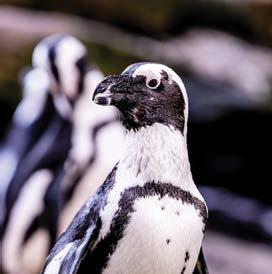








Schools of colourful fish, too-cute penguin antics, majestic ragged-tooth sharks, glowing jellies, gentle rays and the ever-elusive octopus – these are the reasons you’ll keep coming back to the Two Oceans Aquarium, where every visit is an underwater exploration. Unlock unlimited visits for yourself and your family with Two Oceans Aquarium annual memberships and visit the fish as often as you wish!
Explore the Aquarium your own way! Scuba dive in our exhibits, meet a rockhopper penguin up close, take a guided tour, and watch our animals being fed in the presence of our expert presenters. Come and discover our underwater world.

Buy tickets online www.aquarium.co.za
the
Let the Explore and let your creativity shine with puzzles & pictures!
iles There are more than 10 000 species of reptiles recorded.
Reptiles are ectothermic. This means that they get their body heat from external sources. For example, reptiles bask in the sun when cool and seek shade or water when hot.
Colouring in



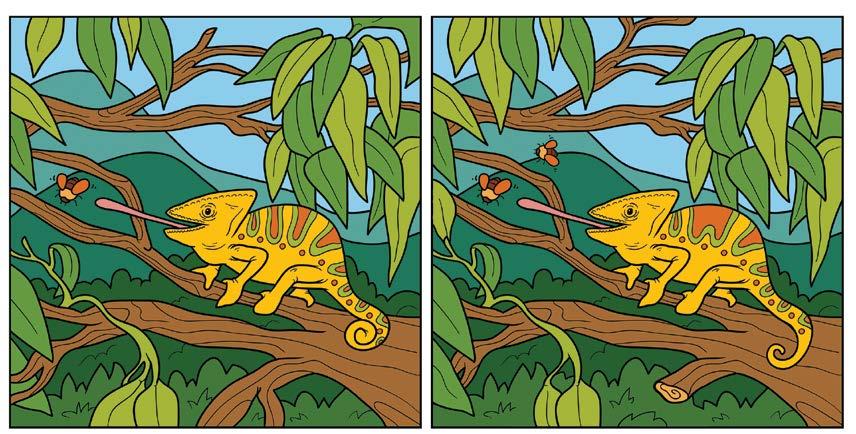
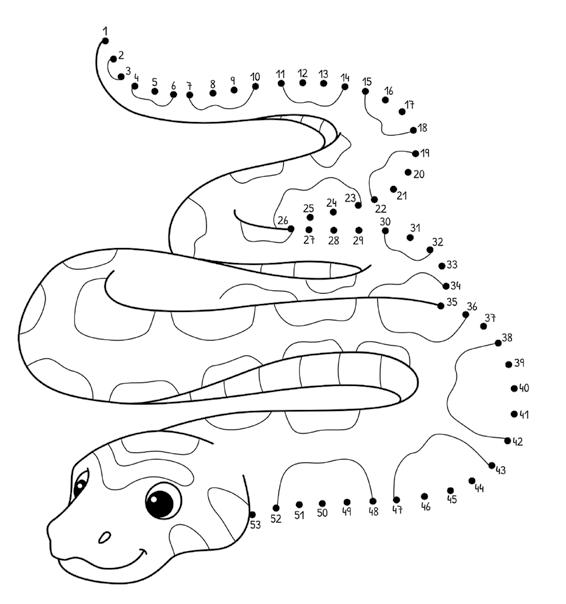
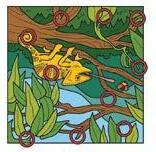
Most reptile species lay eggs, but there are some such as certain viper snakes that give birth to live young.
Reptiles have scales, and depending on the species the scales differ in size, shape, and structure.


Stimulate

a v
s i i c h o r s i o h a c w i h d k e y
k s e m o k u v f i n f l u e n z a w r
i a b p r a f i t n e s s f u b l x v o
n t u m e p e l o o a z t e t m e f c t
e i a h x c l d e v e l o p m e n t w a
x o u s i e u l b m s t p w e a i d p r
r n o t a f k p d u h m i k h c c u e i
a v p o s t p a r t u m u u a f c r i p
l w a e x p a l p s p e e c h z a o t s
b a i n m o s n i t a w z v b e v w a e
s p t e v c t l a a d v e n t u r e t r
v t b t e a m w o r k r e t n i w t f r


Fertilisation
Antenatal
Postpartum
Piles
Respiratory
Vaccine
Influenza
Insomnia
Orthorexia
Fitness
Retinol
Burns
Teamwork
Speech
Development
Adventure
Winter
Play
Book
Skin

To enter scan the QR code with your phone and complete the entry form online at www.babysandbeyond.co.za/competitions/ Closing date: 31 August 2024. T&Cs apply. Stand



Vaginitis a ects many women daily.
But asking for treatment might be di cult.
Femoxil’s #PINKBOX has therefore made it easy to nd and recognize a treatment that works.
Use Femoxil’s #PINKBOX and experience relief from:
• Vaginal Pain
• Tenderness and discomfort
• Itchiness
• Burning
• Irritation
• Dryness





Hemorrhoid pain can sometimes feel like sitting on a toilet seat full of nails.
But, treatment should not aggravate or lengthen the su ering.
Therefore insist on the quick relief provided by Presto Gel with Aloe Vera.
Presto Gel contains only natural ingredients that form a protective layer around the hemorrhoids allowing the body to quickly relieve the pain, burning, itchiness, and bleeding and assist with healing.
Presto Gel works when other treatments have failed.

























This DIY experiment will show you how to make a worm farm and give an understanding of the decomposition of food waste.
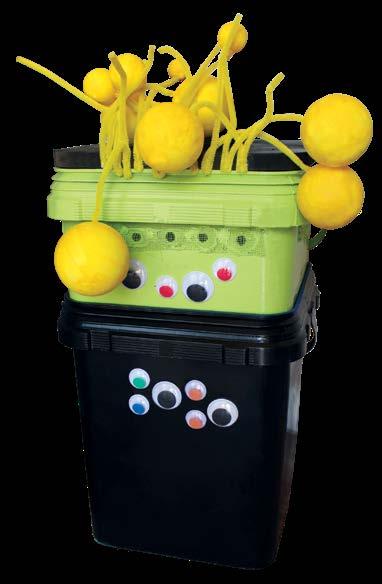

This project is suitable for any year level to develop good recycling attitudes and understand how helpful worms can be in processing our food waste. Earthworms have a lot to teach us. Science experiments with earthworms can demonstrate how you can utilise compost to benefit your garden and what types of food worms eat.
Items that worms love to eat include vegetable matter, paper serviettes, paper towels, and coffee grinds. Avoid meats, juice boxes, anything waxed, plastics and animal faeces. The worms prefer smaller pieces, so large items like banana peels should be torn up.
You will need:
2 (or more) x 20-litre buckets (these can be old buckets you have at home, but ensure they are clean)
1 x bucket lid (you can use the original lid, or make a simple wooden top for easy handling)
Mesh or shade cloth
A drill
10mm spade bit and 5mm drill bit
Waterproof glue (or glue gun)
Fine sandpaper
Scissors
2
Using the spade bit, drill holes around the outer top part of the bucket.
1
Use the sandpaper to roughen up the surface around the holes inside the lid.
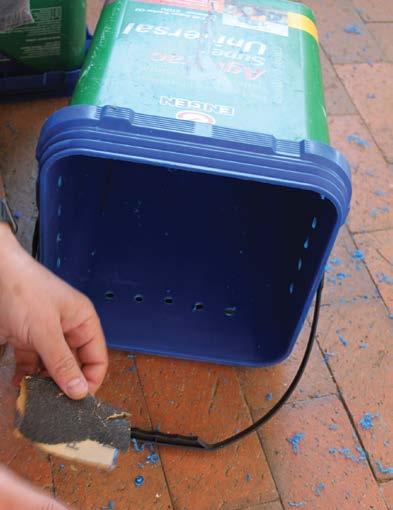
Water
Spray-paint, craft paint, googly eyes, pipe-cleaners and polystyrene balls
Newspaper
Kitchen scraps
Red Wiggler Earthworms (approx. 100 worms)

Put glue around each hole and stick your squares or strip of the mesh over each hole – ensuring they are completely stuck down. Set aside to dry.
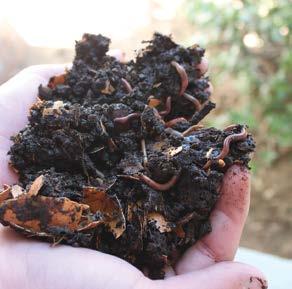
3
Cut eight squares of the screen or shade cloth (large enough to cover the holes – roughly 4 x cm).

4

5
Switch drill bits and then drill a series of holes in the bottom of a bucket.

9
Place the worms in the top bucket – if you have bought them from a worm farm supplier, they will come in a layer of peat moss – add all of this into the bucket.
Add a layer of wet newspaper and top with more vegetable matter.

6
Spray the buckets outside with a plastic adhesive spray paint.

Have fun with your scraps monster and decorate it with googly eyes, pipe cleaner hair, and painted polystyrene balls.
7
Place this bucket inside the 2nd bucket. 8
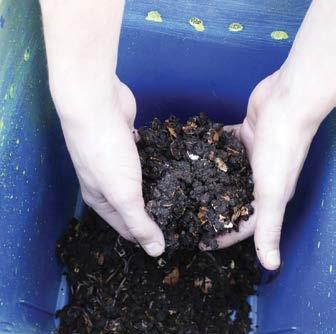
Cover with a lid and leave in a cool, shaded area so it doesn’t dry out. 11 12 13 14
Top with wet paper or cardboard (torn-up pizza boxes work well).

Add more kitchen scraps daily and always top with a wet paper or cardboard layer.
Once the food waste reaches the level in the bucket, you can stack another bucket on top of the worms. You can add another bucket with holes drilled into the bottom without squashing them. Just be careful not to add more than ±20 cm of kitchen scraps because the worms can get crushed under the weight.
Collect the “worm tea” after 2 to 3 weeks from the bottom bucket and dilute 1:3 in water to use in your garden. Scan
15


Baby nursery & kids linen sets

Braided
Feeding pillows
Fleece blankets
Wall decor / canvas sets
Babyshower gifts
Milestone blankets & many more!


Email: ronel@kotteljonsie.co.za
Facebook: @kotteljonsieboutique www.kotteljonsie.co.za


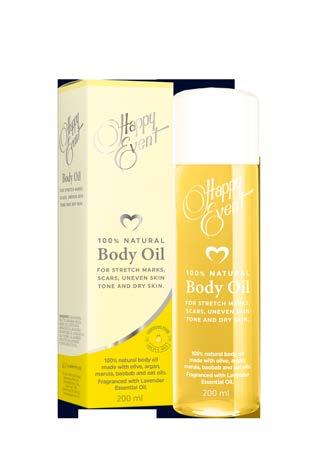

Recipe by Noxolo Ncalane
Ingredients
5ml fine black pepper
5ml garlic and ginger paste
5ml cayenne pepper
5ml dried rosemary
5ml oregano
a sprig of curry leaves
3 carrots, sliced
2 bay leaves
100g shredded cabbage
Method
In a medium sized pan, heat the oil, and add the carrots and onions. Cook until onions are translucent.

2 whole medium stalks of celery, sliced
1 medium sized onion, chopped
500g chicken breasts, cut into strips
1 litre boiling water and chicken stock
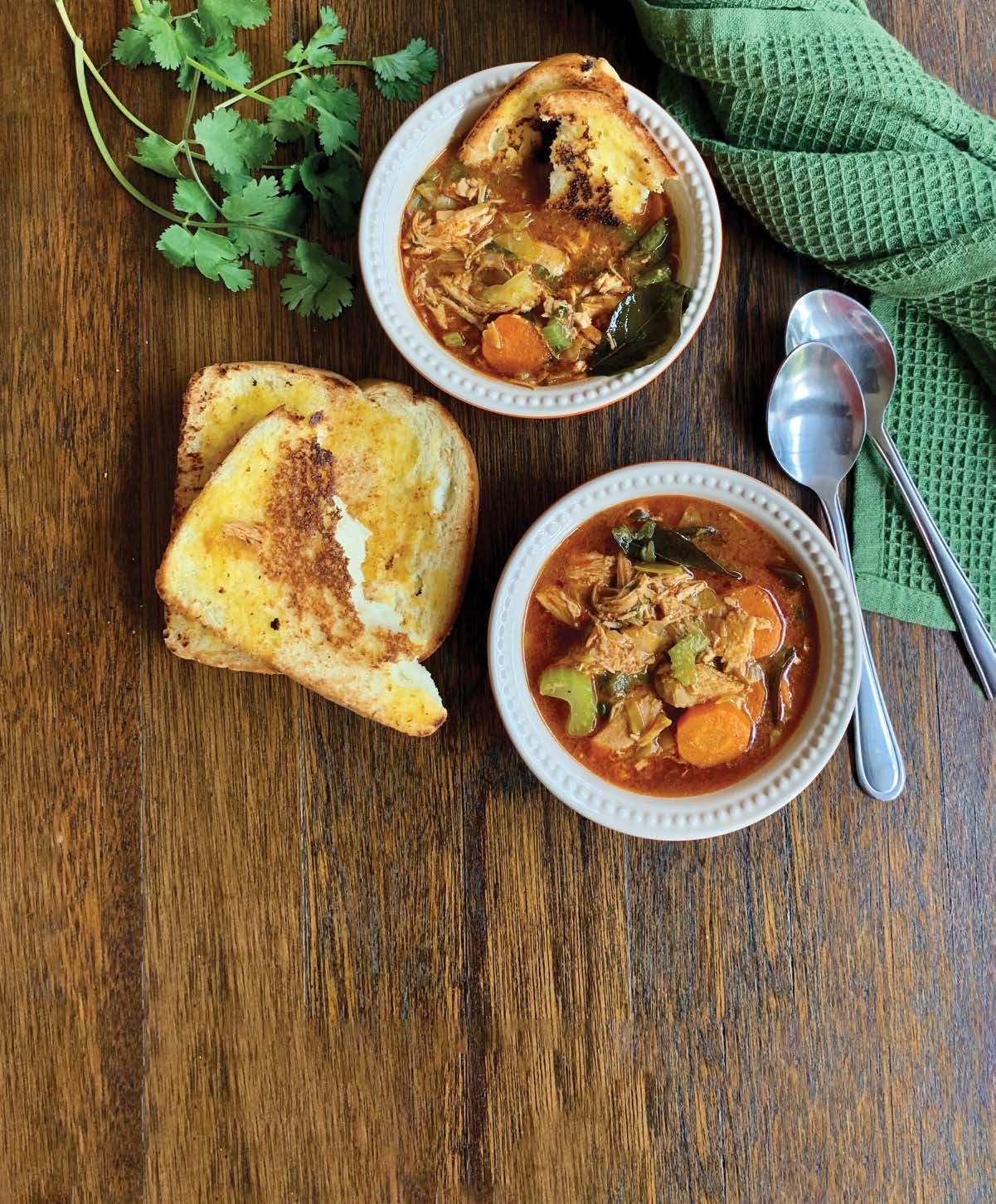
Add garlic and ginger, rosemary, black pepper, oregano, bay leaves, cayenne pepper, and curry leaves. Cook until fragrant, a maximum of 3 minutes on medium heat.
Add the cabbage and celery and cook for 3 minutes. Set pan aside.
In a pot, add your stock and chicken Allow to simmer for 30 minutes. Remove from the pot and shred the chicken into pieces, then return to the pot.
Decant the vegetable contents of the pan into the pot with liquid stock and chicken.
Allow to simmer for 15 minutes
Season with salt and pepper
Enjoy with freshly toasted bread with butter. 1 2 3 4 5 6 7 8 9
Garnish with chopped fresh parsley.




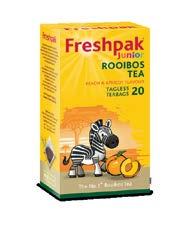



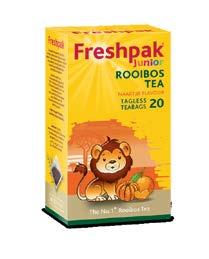







Goodness comes naturally for your whole family
Looking for a healthy alternative to sugary drinks? Specially formulated for Kids, Freshpak Junior Rooibos Tea is naturally ca eine free and can be o ered to children at any time of the day. Rooibos Tea is a natural source of polyphenols, a bene cial antioxidant.
Scan for refreshing iced tea recipes
































